About The Photographer
Miroslav Asanin is a keen amateur photographer based in Sencur, a small town in the vicinity of Kranj, the capital of Gorenjska region, which is part of the Slovenian Alpine area. He is lucky enough to live in an area of outstanding natural beauty which inspires him daily. His main photographic interests are landscapes and nature though he does photograph wildlife and architecture when he finds them. He tries to take his camera with him everywhere he goes, as one never knows when he’s going to spot an amazing shot.
Miroslav’s interest in photography started in 2012 when he got his first proper DSLR camera, a Canon EOS 600D. With the convenience and immediate feedback of the DSLR cameras he soon became hooked on spending time in nature and creating images of the unbelievable beauty of the landscape under many different conditions. His main photography haunts are around the northwestern part of Slovenia, which is home to some of the most beautiful and diverse scenery in Europe. Miroslav especially loves to photograph the amazing landscapes and nature of the Triglav National Park and the Slovenian Alps. However he also loves to take day trips to other parts of the country and scout new locations as much as possible in search of compelling scenes or subjects to photograph.
Below is a selection of landscape and nature photos from around Slovenia that Miroslav Asanin kindly shared with us. And if you like Miroslav’s photographs, you are welcome to check out his Facebook and Instagram pages for more of his work. You can also contact him anytime if you are interested in purchasing a print for any image you see there or if you have any questions or would just like to chat about great spots for taking photos in Slovenia or anything else, for that matter.
Photo Gallery
A picture gallery containing 50 beautiful landscape and nature photos from all over Slovenia by Miroslav Asanin.
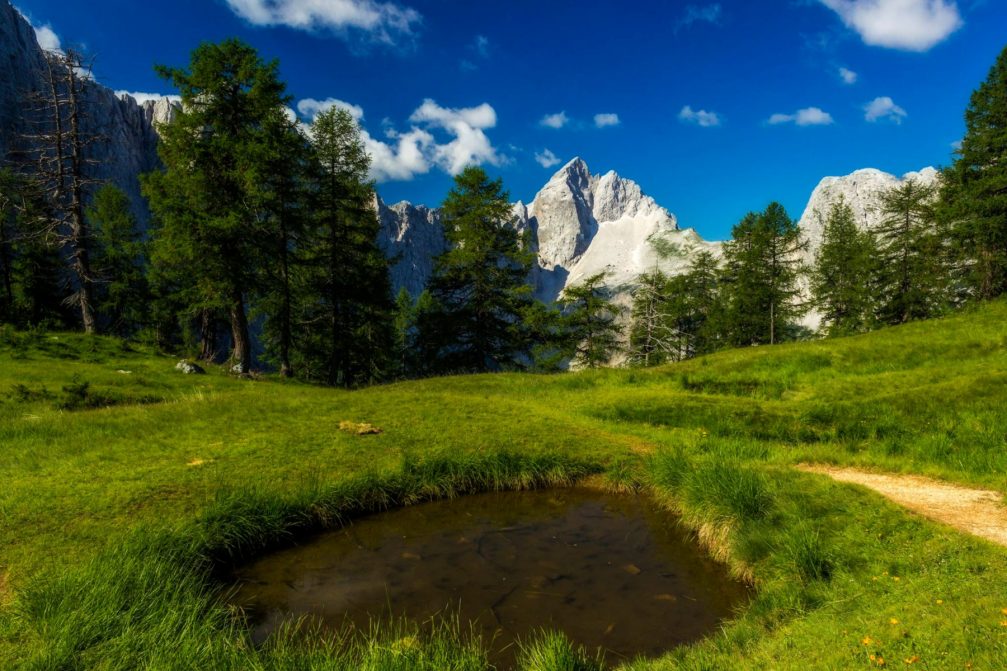
The Triglav National Park covers an area of over 800 square kilometres (4% of Slovenian territory), almost across the entire area of the Julian Alps in northwestern Slovenia. It is one of the largest and oldest national reserves in Europe and an undiscovered hiker’s paradise — a pristine, visually striking world of rocky mountains. It’s crowd-free and teeming with beauty, history and exciting hiking options ranging from short and relaxing walks to single-day excursions to challenging and strenuous multi-day long adventures.
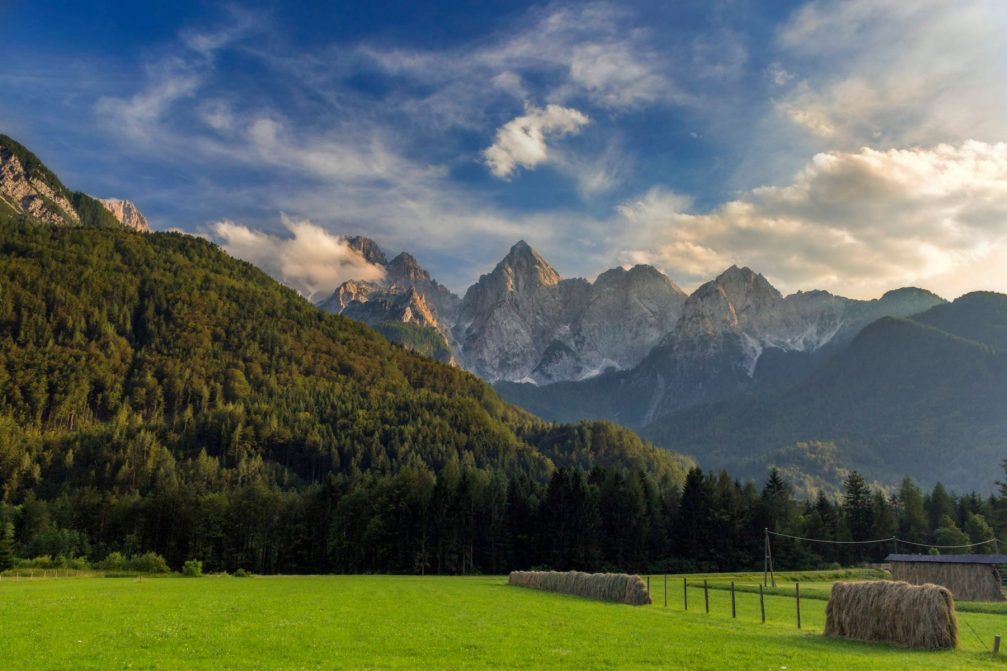
The Upper Sava Valley or Zgornjesavska Dolina as it is called in Slovene is tucked between the unspoilt nature of the Triglav National Park in the Julian Alps and the Karavanke mountain chain, in the utmost northwestern part of Slovenia, close to borders with Austria and Italy. It is an idyllic spot to live and enjoy nature and offers spectacular mountains views and scenery.
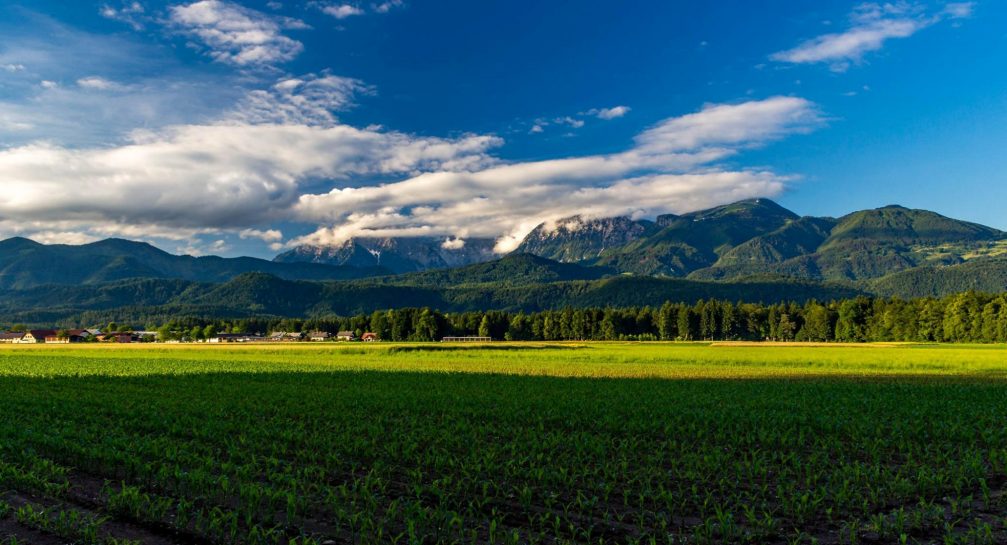
Every spring the fields in Slovenia are plowed, making the soil ready to receive the seeds that the farmer has chosen to plant. Maize, wheat, oat, spelt, triticale, rye, buckwheat and barley are the most spread cereals while sugar beets, soybeans, sunflowers and rapeseed are the most spread industrial crops.
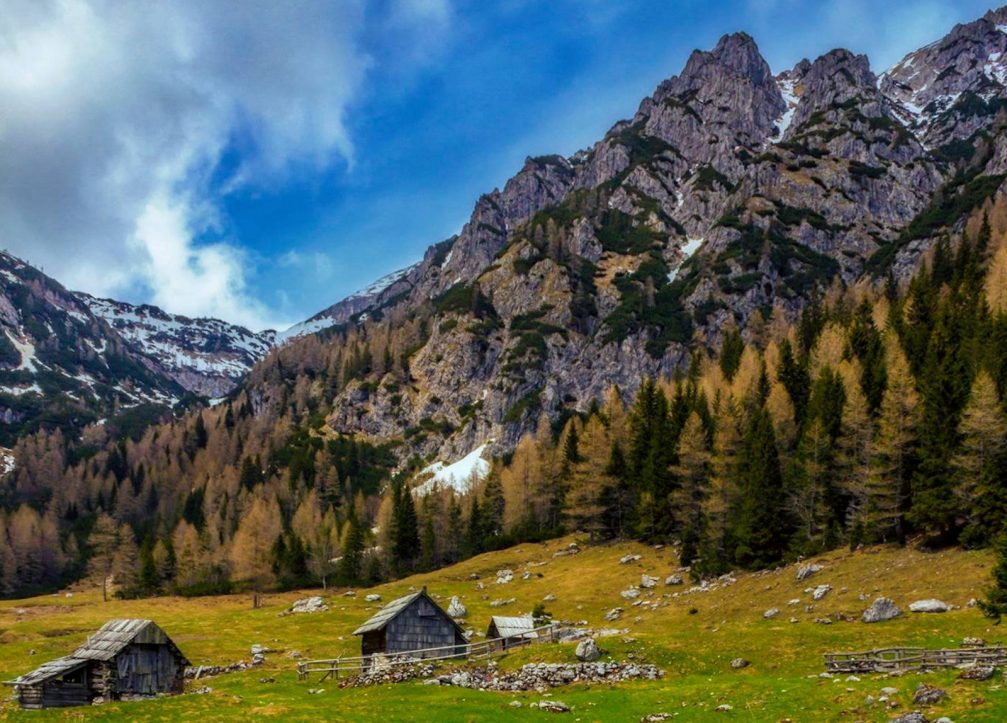
At an elevation of 1,438 meters (4,717 feet), Konjscica is a beautiful alpine meadow on the Pokljuka plateau dotted with several shepherd’s huts, one of which has been converted into a cheese dairy.
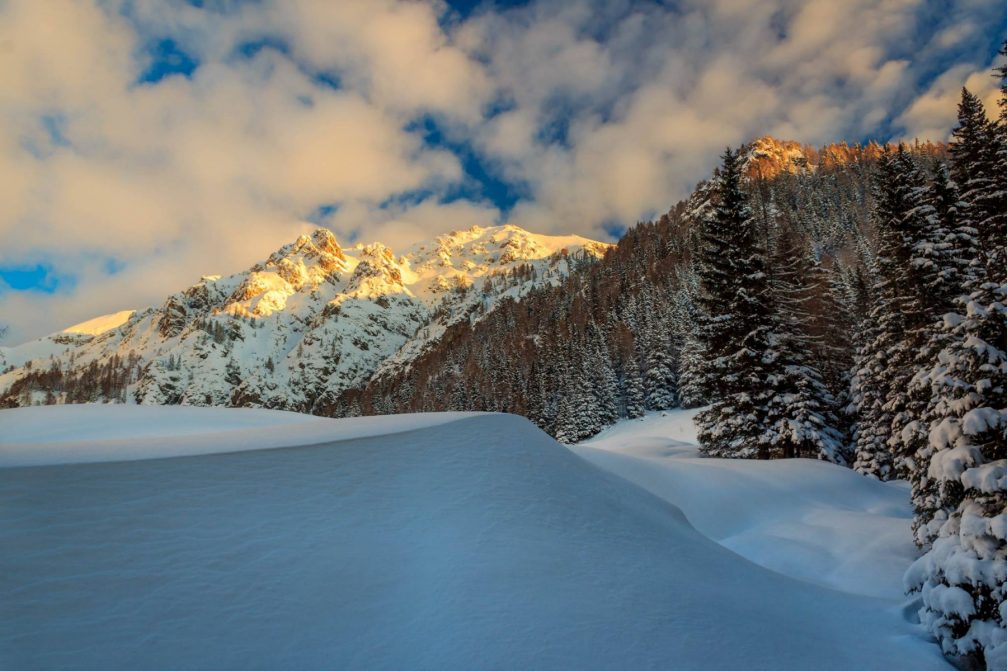
In winter, the Konjscica alpine meadow feels like a magical fairytale with a thick covering of snow, which could last from late November until April.
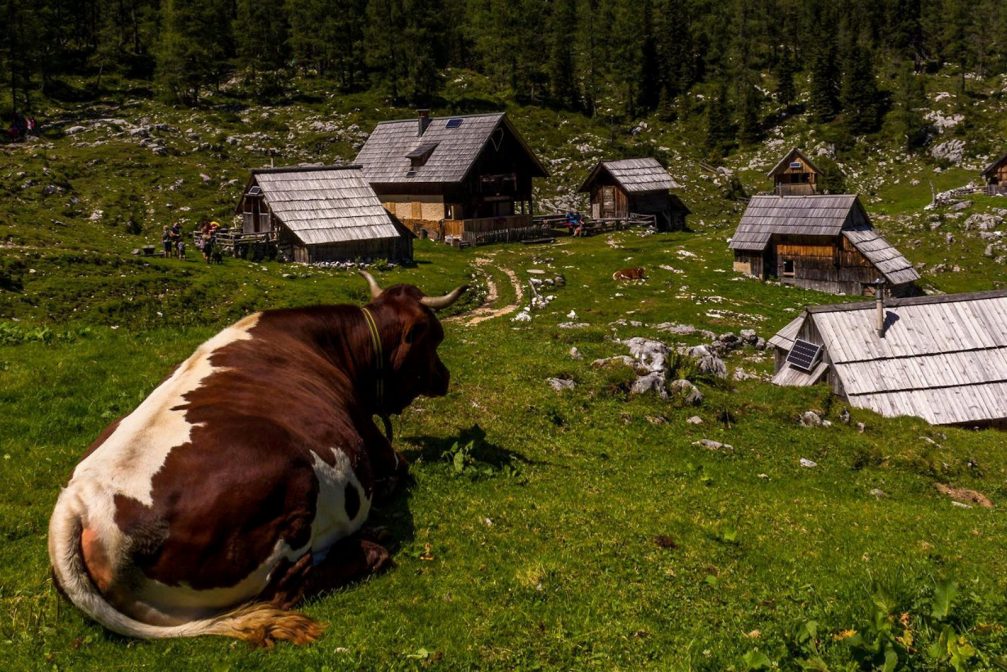
Dedno Polje is a high altitude pasture area in the Julian Alps at an elevation of 1,560 meters (5,118 feet). Though most of the shepherds’ huts have been converted into weekend vacation dwellings, local farmers still produce cheese, sour milk and other dairy products here which are available for sale during the summer months (from June to September).
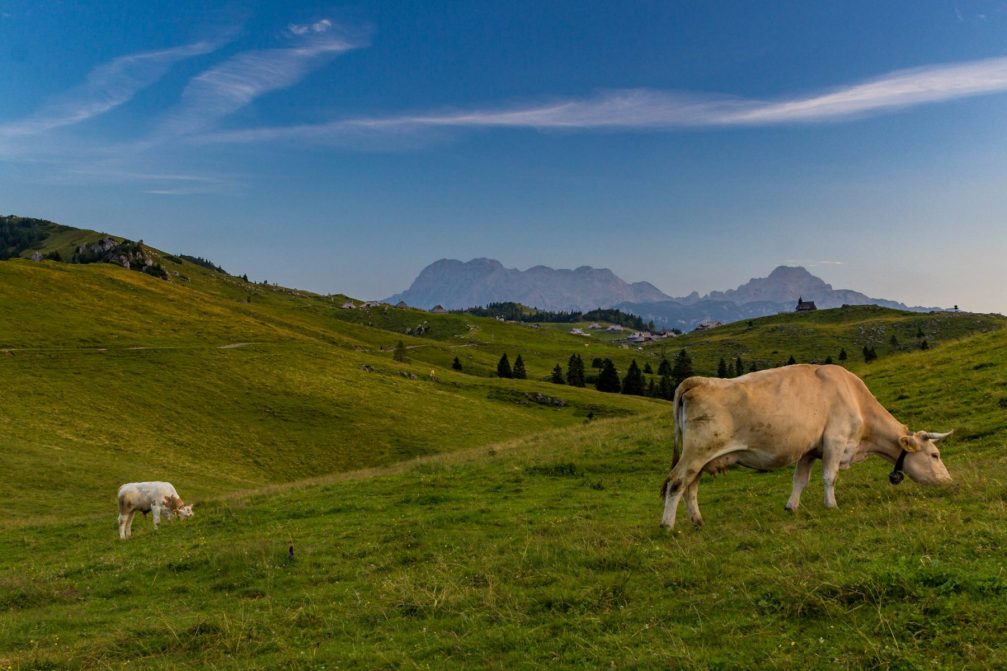
Located in the heart of the Kamnik-Savinja Alps in northern Slovenia, Velika Planina is one of Europe’s largest and most beautiful Alpine pastures. Local herdsmen drive cattle up from the valleys to Velika Planina each June and remain here, with their livestock, for the rest of the summer season.
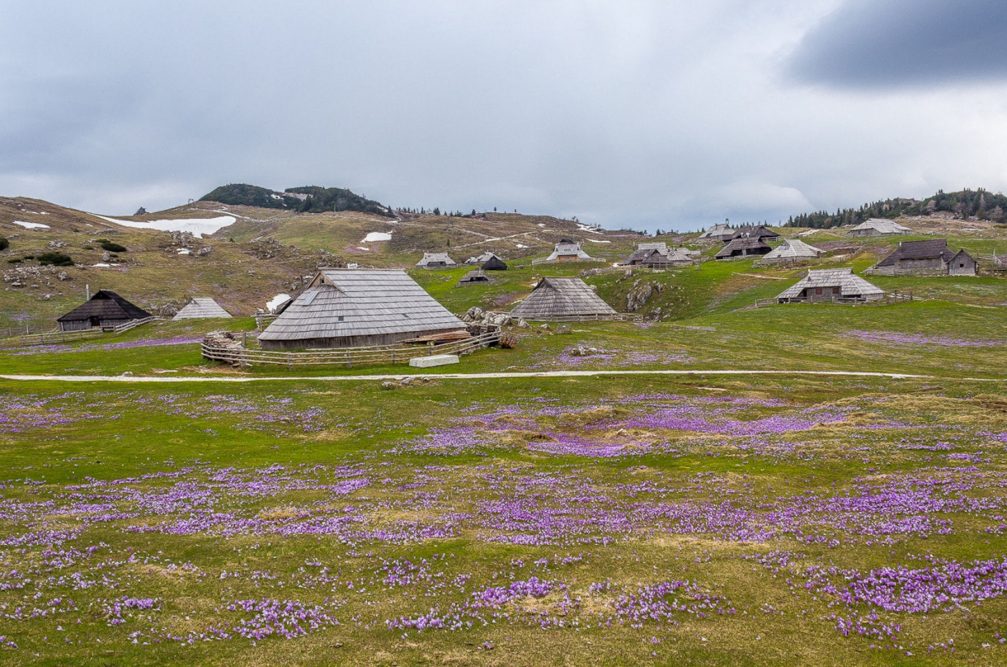
Velika planina is dotted with semicircular wooden huts that cannot be found anywhere else on the planet. Designed to provide shelter for both humans and livestock, the unique huts date back to the Middle Ages and are among the most interesting examples of vernacular architecture in Slovenia.
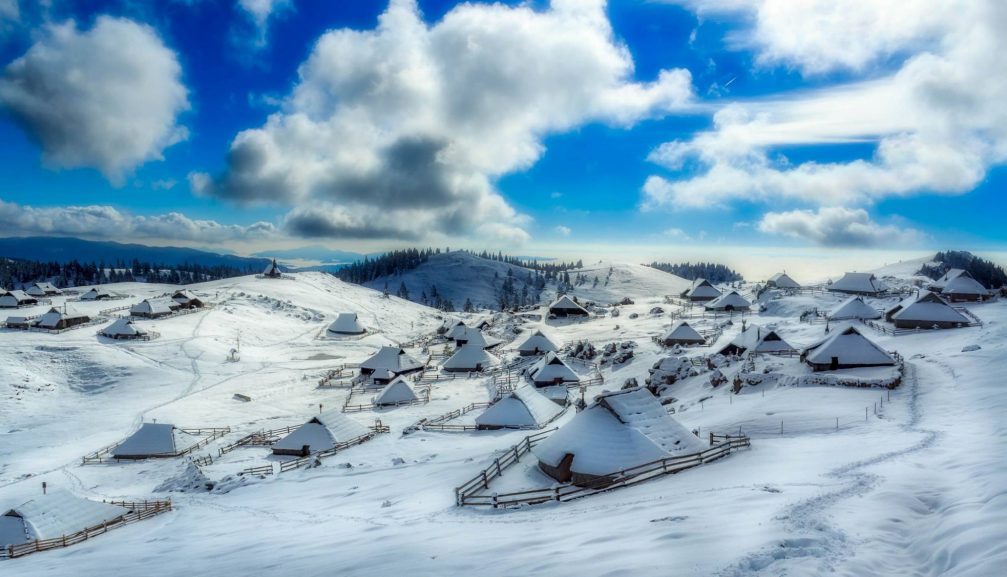
Some visitors have likened the Velika Planina high-elevation settlement to a Hobbit village. And there is indeed something fairytale-like about Velika Planina, especially in winter when it really looks like something out of a story book with all those wooden little huts hidden under a thick covering of snow.
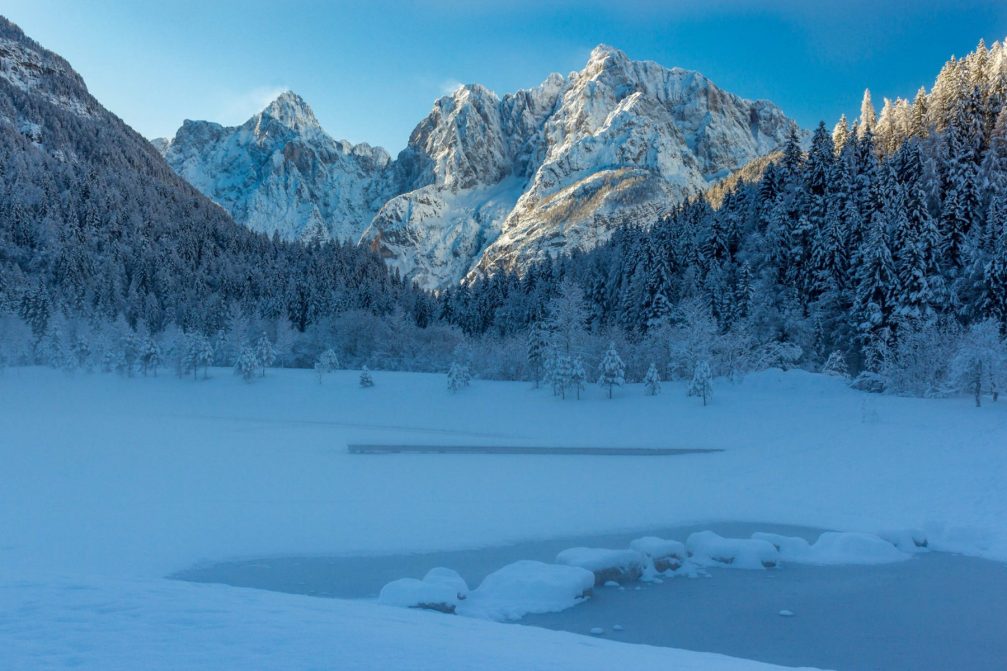
With the Julian Alps as a dramatic backdrop, Lake Jasna is just one of the many incredible natural sights around the village of Kranjska Gora in the far northwestern corner of the country. In winter, the lake freezes and is covered with snow.
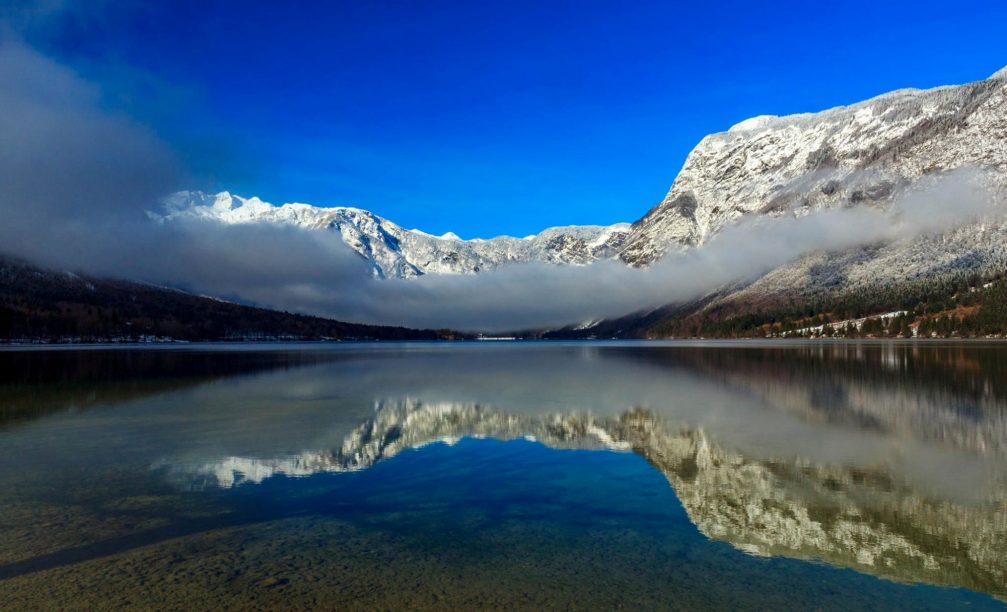
Tucked into the southeastern corner of Triglav National Park, Lake Bohinj is Slovenia’s largest lake with high mountains on almost all sides. Fed by crystal-clear mountain streams, it is perfect for swimming and kayaking and a great base from which to explore the hiking trails in the Julian Alps. In winter, the frozen lake provides a great opportunity for ice skating.
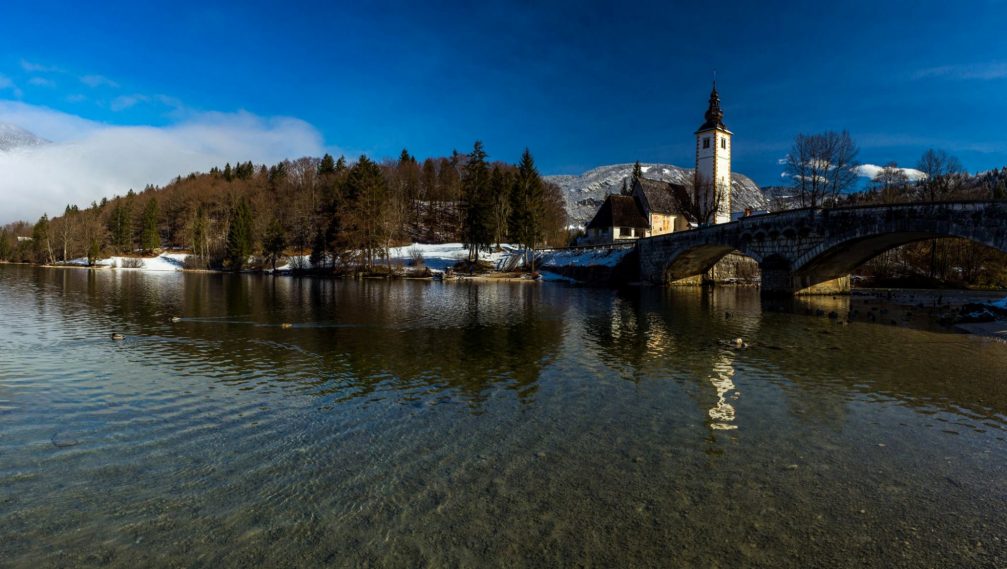
The Church of St John the Baptist stands opposite the small stone bridge and offers great views of Lake Bohinj. The church is the most interesting building in the Bohinj area. It has its origins in the 13th century, but has undergone several revamps throughout its rich history and now features a baroque-style bell tower, the 14th-century frescoes and the 17th-century altars. On the outside wall is a faded mural of St. Christopher with baby Jesus on his shoulder.
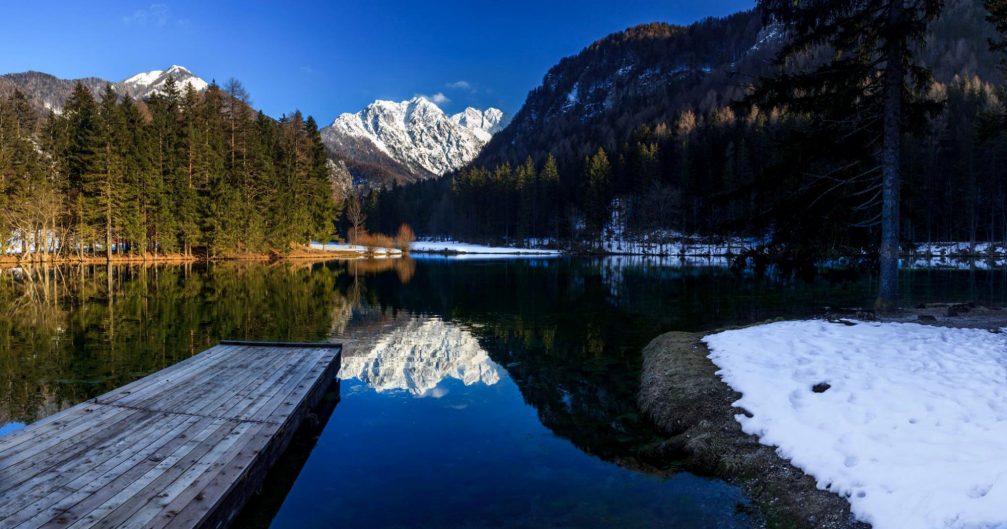
There used to be a big lake in the Jezersko valley that disappeared due to a severe earthquake in 1348, which explains how the valley got its name – ‘Jezersko’ being Slovene for lakeland. About half a century ago, a group of Jezersko locals created a man-made lake, in the shape of a heart – the beautiful Plansarsko Jezero Lake. A homage to the big glacial lake of the past. During the summer, you can fish or boat in the clear water of the lake. In the winter, expect crowds of locals skating across the frozen surface. This is a very special place that you don’t want to miss!
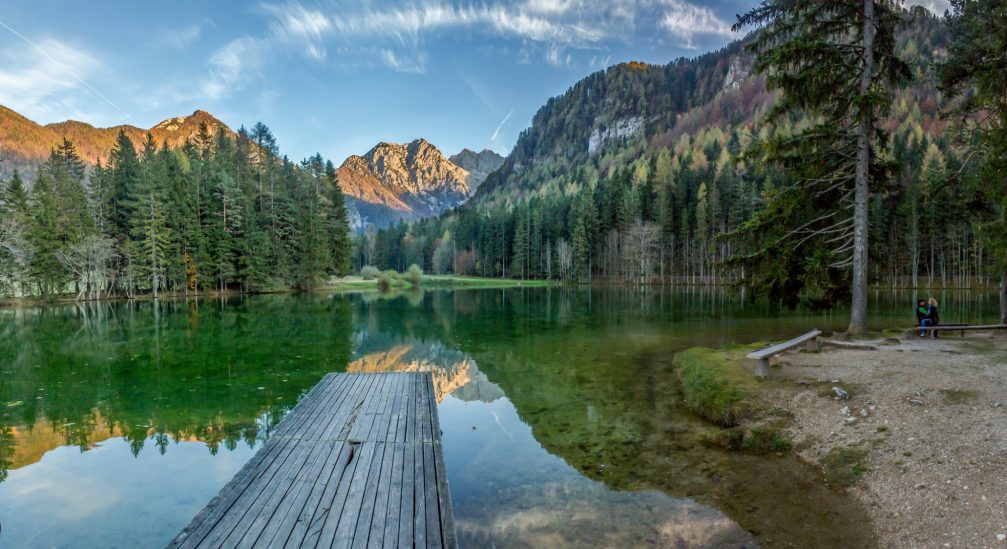
The Plansarsko Jezero lake itself is stunning, thanks in part to the location right at the base of a mountain. However, it is the color and clarity of the water that makes it such an unusual and unforgettable destination.
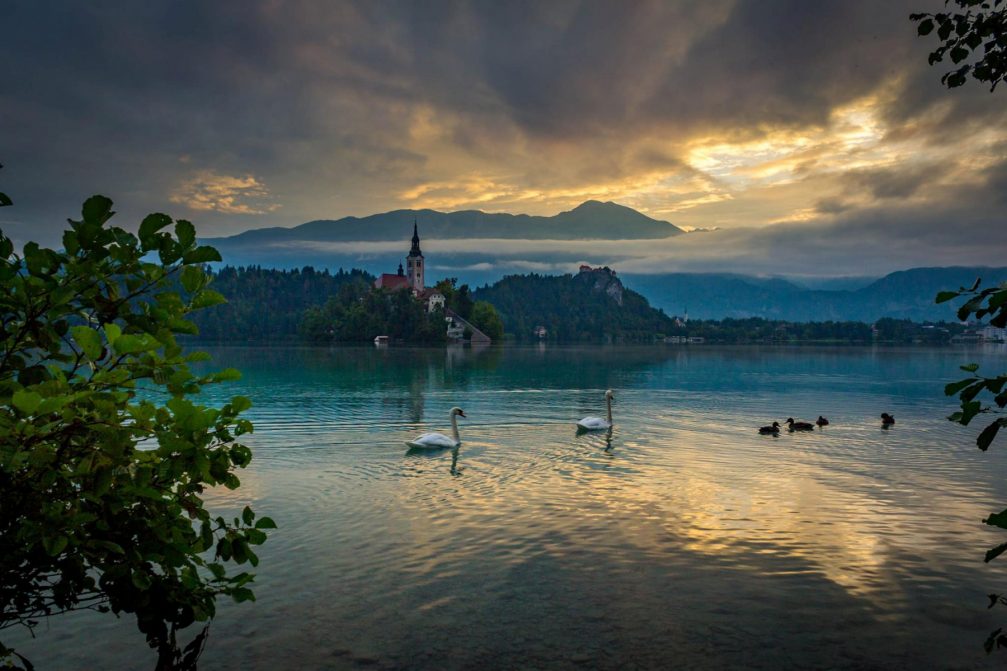
There are many lakes in Slovenia, and they are popular both with travelers and local residents. The most famous and picturesque one is definitely Lake Bled. It is a beautiful lake with a small island in the middle. The castle that stands on an imposing 120 metre high rock and the Karavanke mountain range behind it provide a stunning backdrop to this lake.
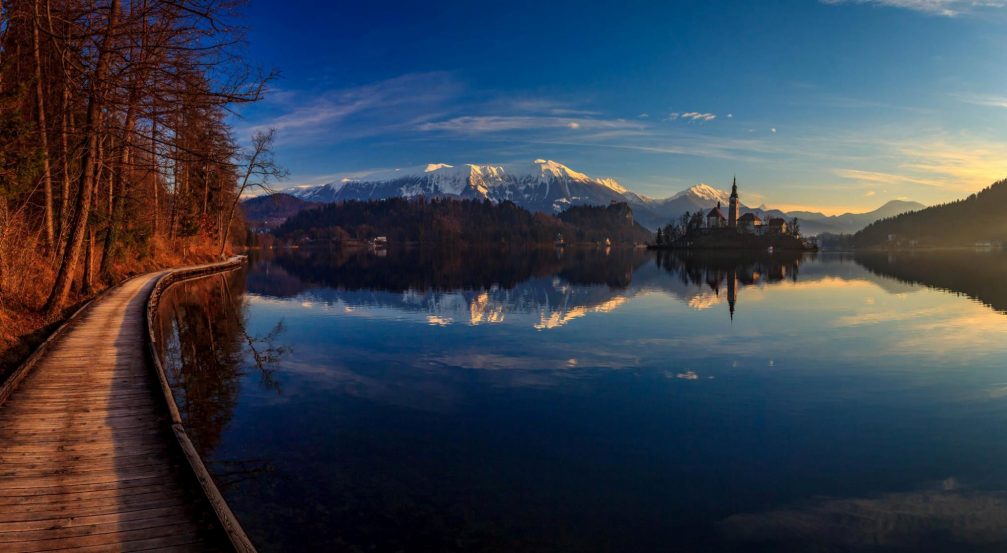
The entire circumference of Lake Bled can be walked in about an hour (6 kilometres) and is a landscape photographer’s dream come true! There are so many picture perfect photo opportunities throughout the walk.
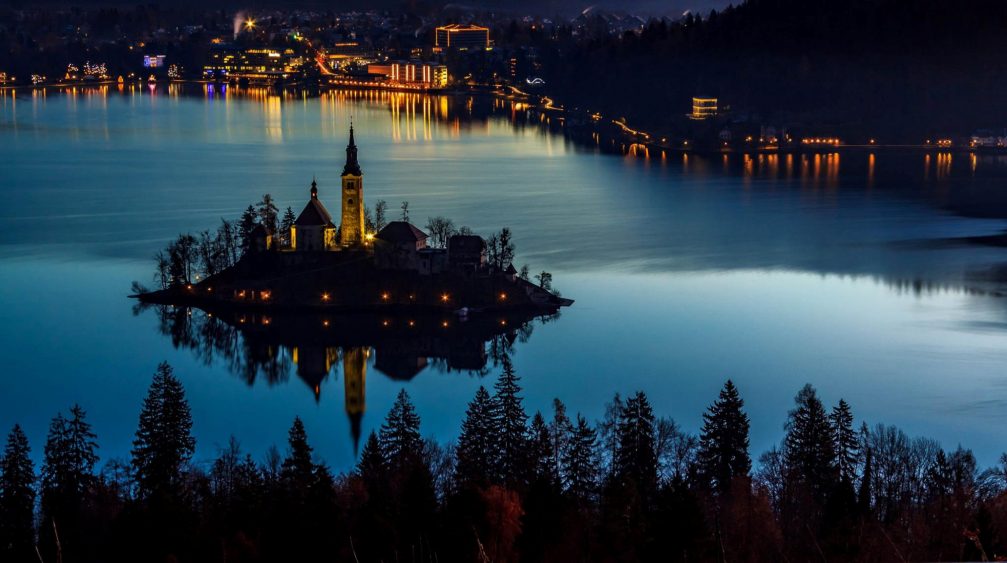
Lake Bled is a lovely, picturesque small lake with a small island in the middle. The beautiful old Gothic Church of the Assumption is located on the island. To get to it, you must hire a Pletna, Slovenia’s version of a gondola.
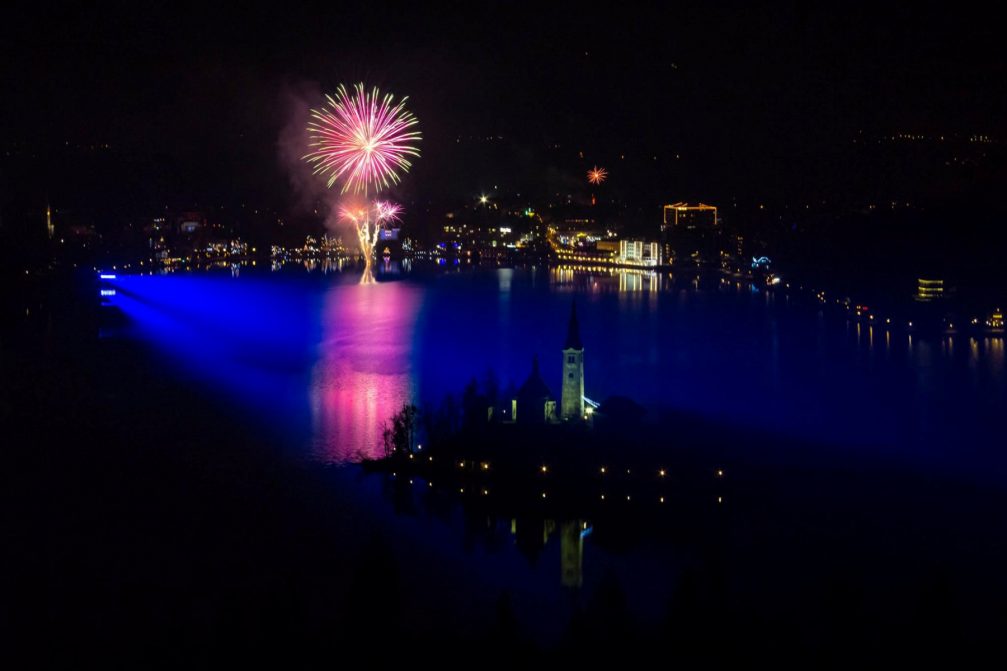
There’s probably no better place to spend a New Year’s Eve than Bled.
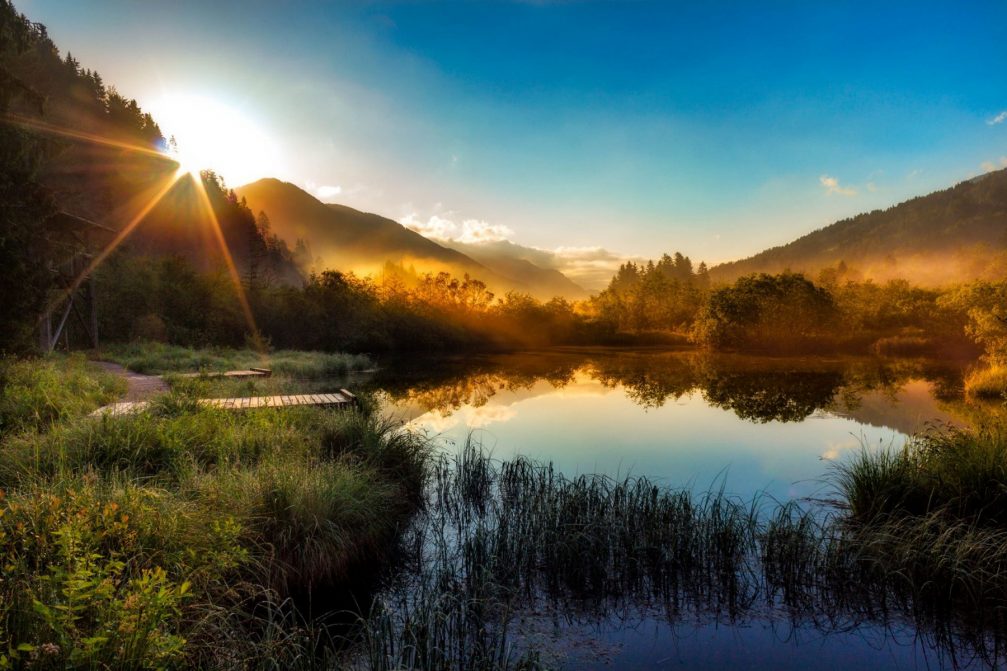
The Zelenci nature reserve is named after the small lake at the western end of the wetlands, whose waters are noted for their dark green colour, thanks to layers of lake chalk. The present lake is the remnant of a much larger lake that existed here after the last Ice Age.
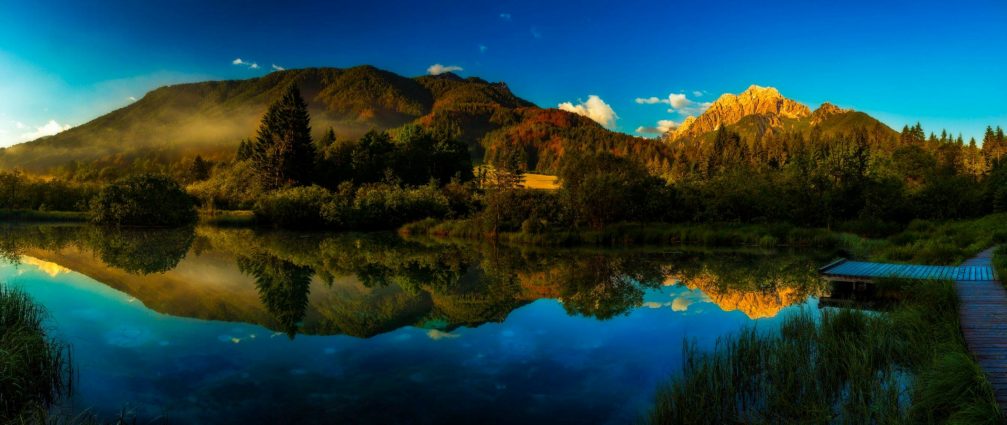
Zelenci has always been admired by those who appreciate and enjoy the beauty of nature and its magical ways of creating things. Sir Humphry Davy, the famous English scientist, was among those who fell in love with this place. Since 1992, Zelenci has been designated as a natural reserve.
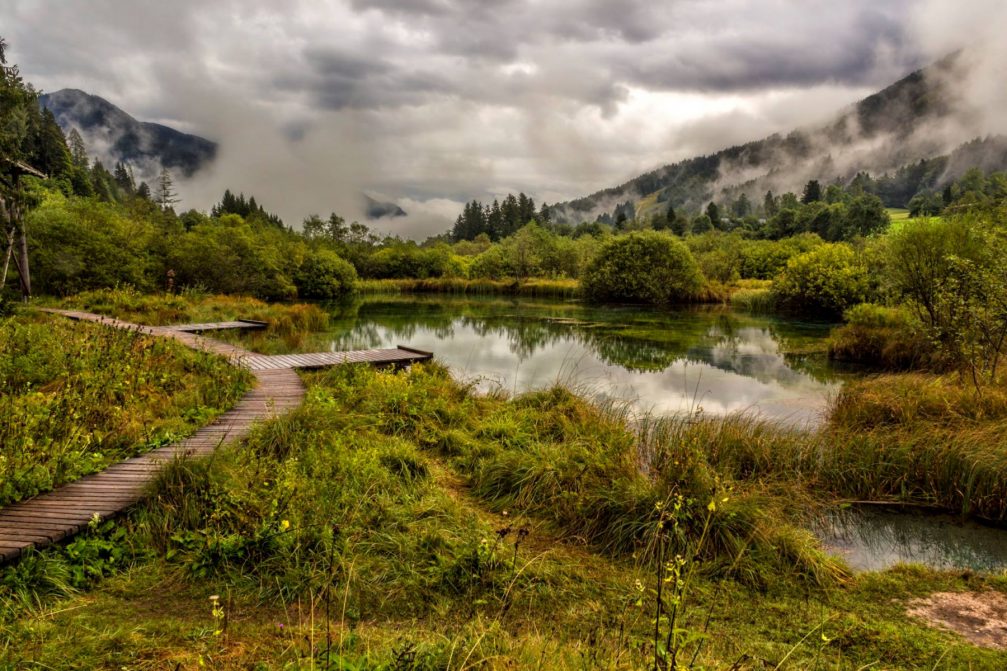
The picturesque appearance of the Zelenci lake and surrounding area attracted numerous painters, including Ladislau Benesch. Today, the Zelenci nature reserve is an inspiration for landscape photographers who unanimously agree that it’s almost impossible to take a bad photo here. But the beauty of the Zelenci nature reserve is not only superficial. It hides small treasures, which can’t be found anywhere else in the world, or which are extremely rare: wetlands plants, such as the critically endangered slender sedge and brown beak sedge, and two carnivorous sundew species. The nature reserve is also home to a variety of endangered animal species, mostly amphibians, and several rare birds.
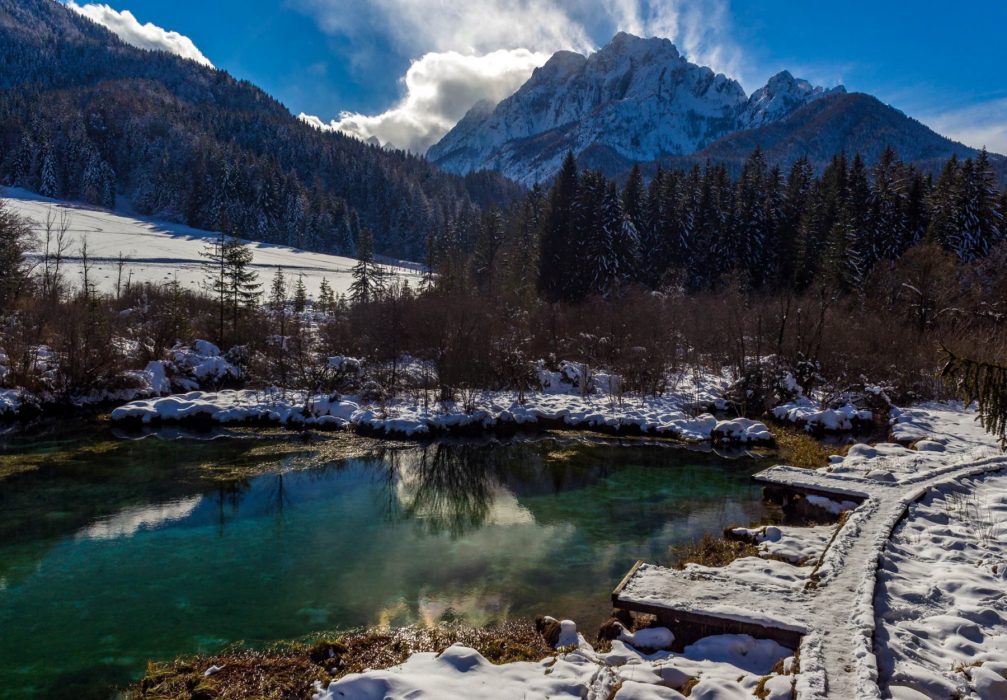
Interestingly, despite the most freezing temperatures and harsh and cold winters in this Alpine area of northwestern Slovenia, the Zelenci lake never freezes. The water has a permanent temperature of 5-6 degrees Celsius throughout the year.
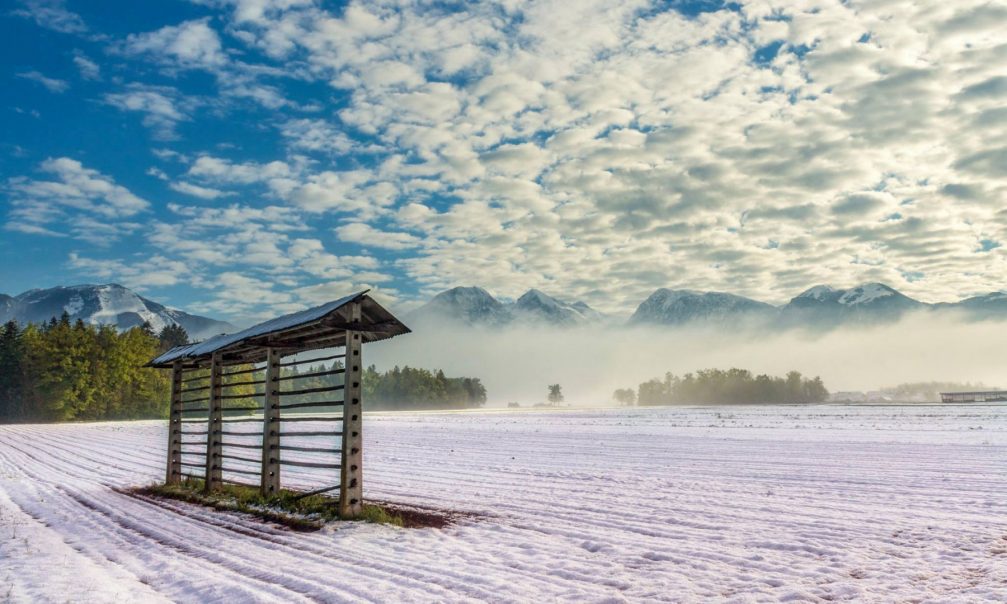
Hayracks or Kozolci as they are called in Slovene are seen almost everywhere around the country. They were developed over time and out of necessity as the damp Alpine regions were not well suited for drying out the hay on the ground. Hayracks come in several varieties: single or double stacked, with and without small roofs, all wood or later versions of concrete pillars and wood slats.
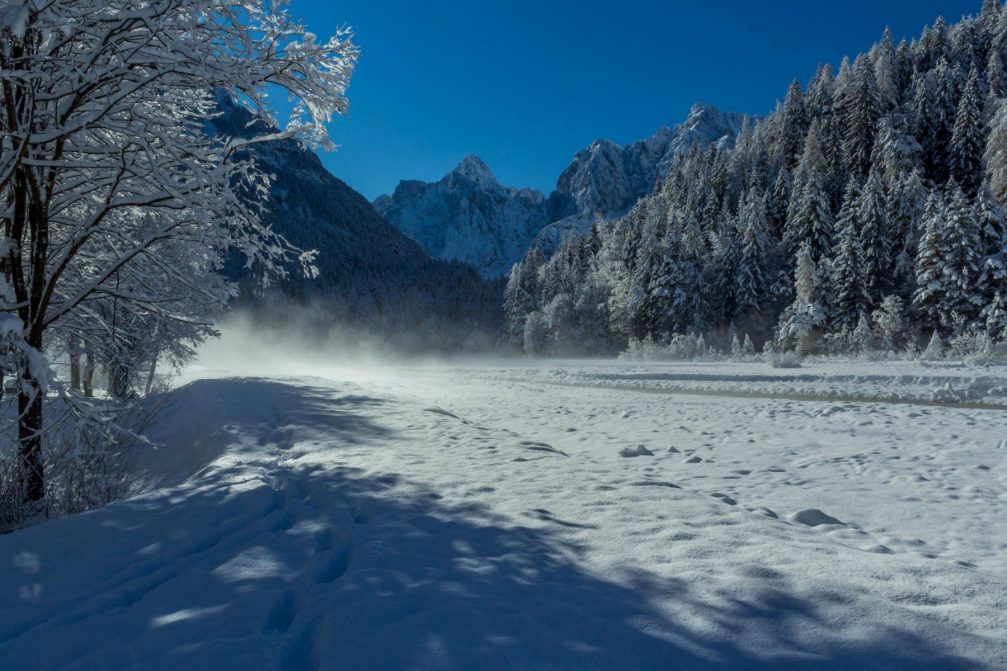
The winter season in the Slovenian Alpine area tends to be quite long and stretches between December and mid-March. Winter weather is cold, with freezing nights and plenty of snow.
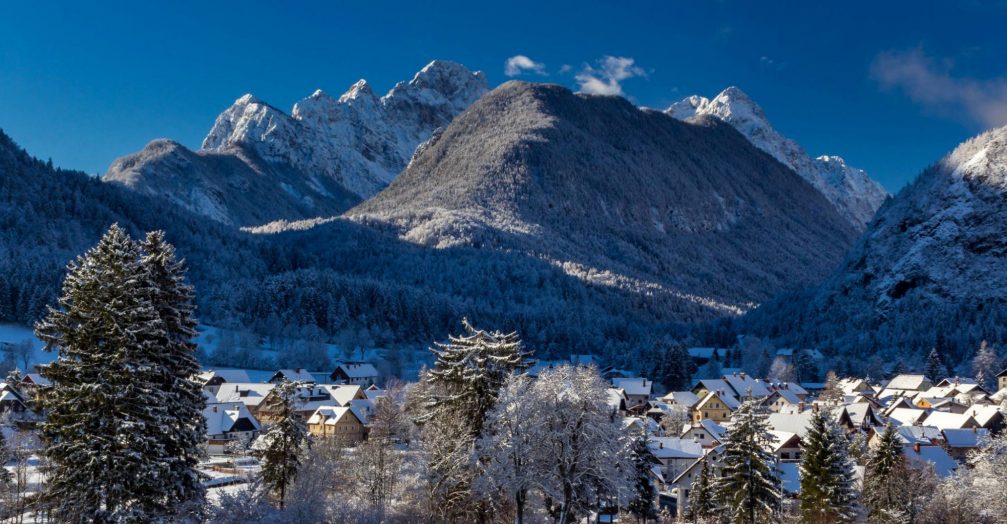
Mojstrana is a charming alpine village situated between the Julian Alps and the Karawanks mountain chain in the utmost northwestern part of Slovenia.
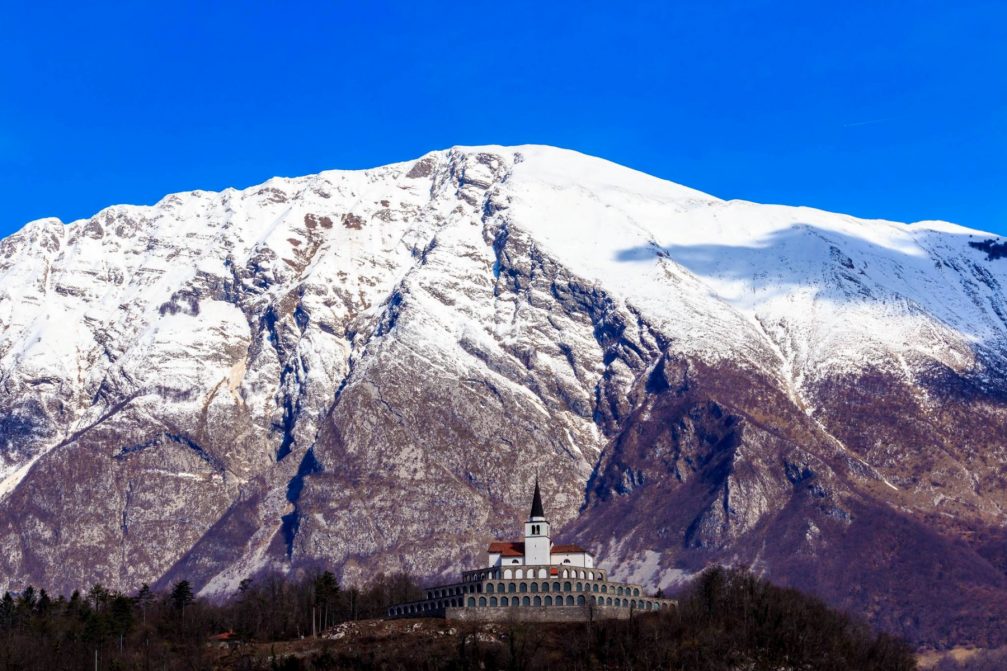
The Caporetto Italian Ossuary houses the remains of 7.014 Italian soldiers who were killed in the infamous Battles of Caporetto during the First World War. It is a fortress-like building on a small hill above the town of Kobarid in northwestern Slovenia, of concentric octagonal terraces ascending towards a small church dedicated to St. Anthony of Padua, which was consecrated in 1696.
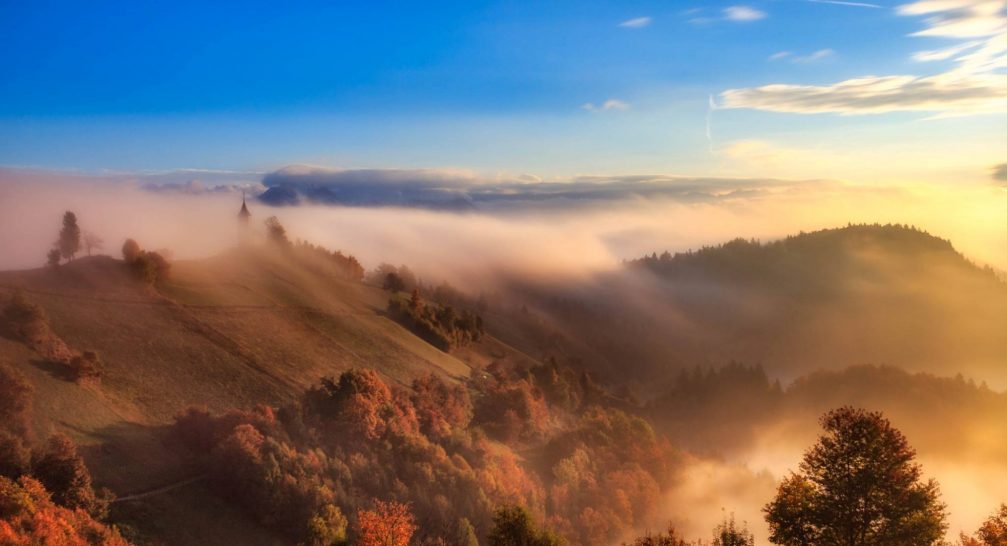
While visiting Slovenia, you will notice there are many hilltop churches in the country. For a classic postcard view of Slovenia with a hilltop church, visit Jamnik, a small village on the eastern slopes of the Jelovica Plateau in northwestern Slovenia. The local church just above the village, dedicated to Saints Primus and Felician, is built at an impressive location on a hill with the Slovenian Alps as a backdrop.
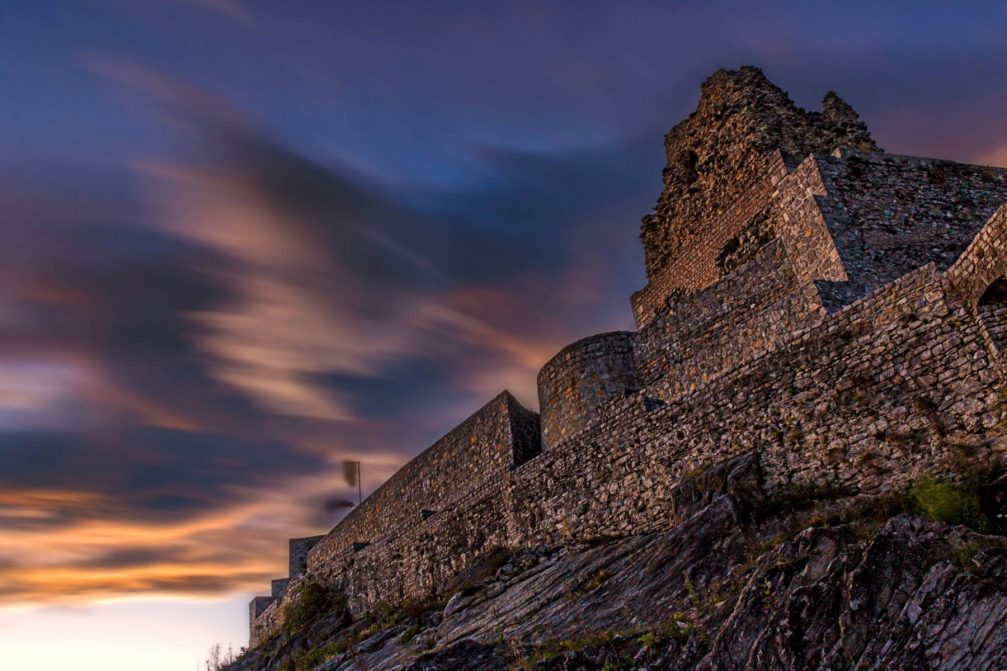
The best known landmark of the Smlednik area in northwestern Slovenia is the Old Castle which was first mentioned in documents dating to 11th century. The castle was then expanded in many phases, but remained unaltered after 1610, and is considered one of the most important examples of the architectural development of a medieval castle in Slovenia. Over the last decade, the castle has been undergoing renovations, particularly its lower southern walls. The main challenge, however, will be the renovation of the central tower, which was nearly 30 metres high.
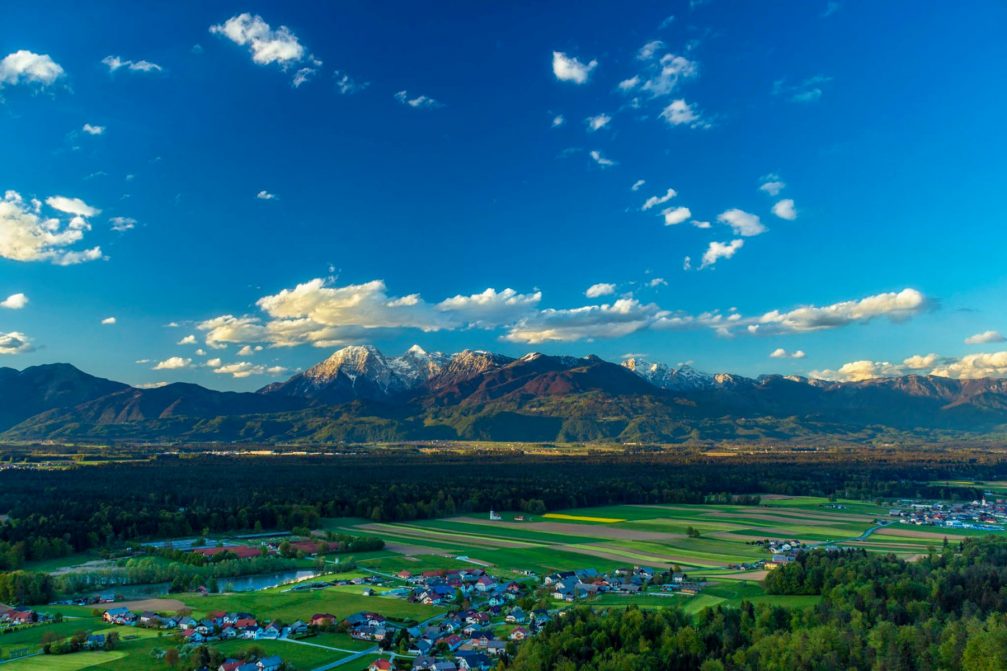
Hrase is a typical Slovenian village, surrounded by farmland and mountain vistas. The local church, built outside the main settlement, is dedicated to Saint James and was first mentioned in the historical record in 1118.
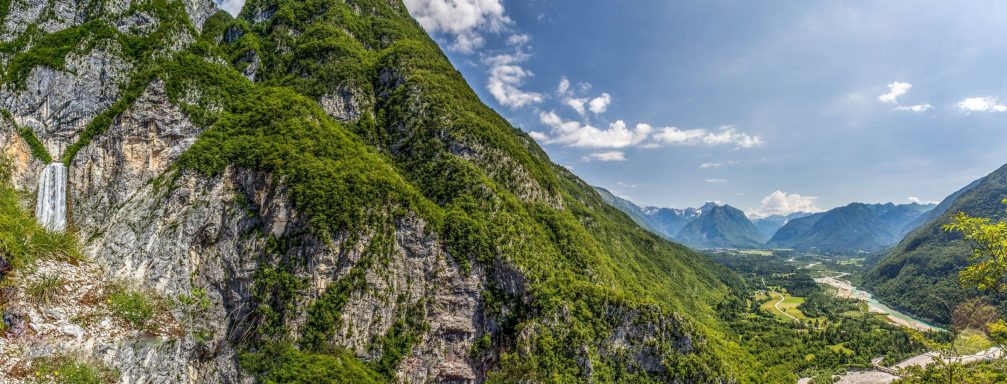
Waterfall Boka (to the left, on the photo) is the highest waterfall in the country with a sheer vertical drop of 106 meters. It’s especially breathtaking in the spring, when the snow in the mountains is melting. It’s located about 5 kilometres southwest of Bovec, a lovely small town that lies in the beautiful Soca Valley (to the right, on the photo).
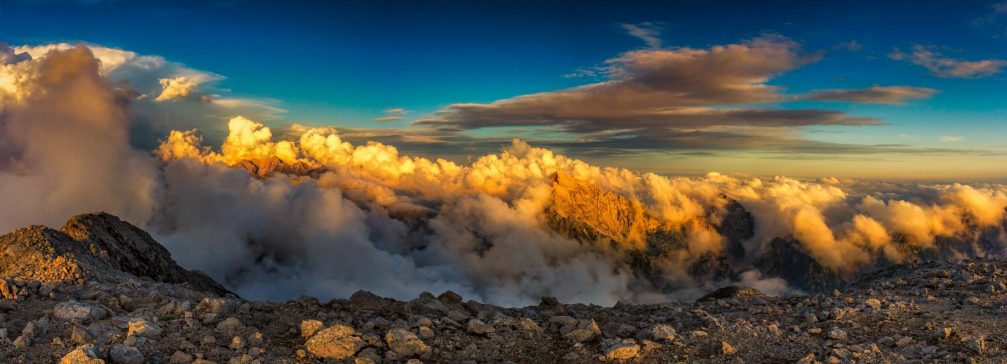
Slovenians are avid walkers, hikers and trekkers, with plenty of trails packed into nearly every corner of the Slovenian Alpine area that appeal to and provide offerings to those of every level, from the technically difficult ascents in the Julian Alps to the more accessible hikes in the Alpine foothills.
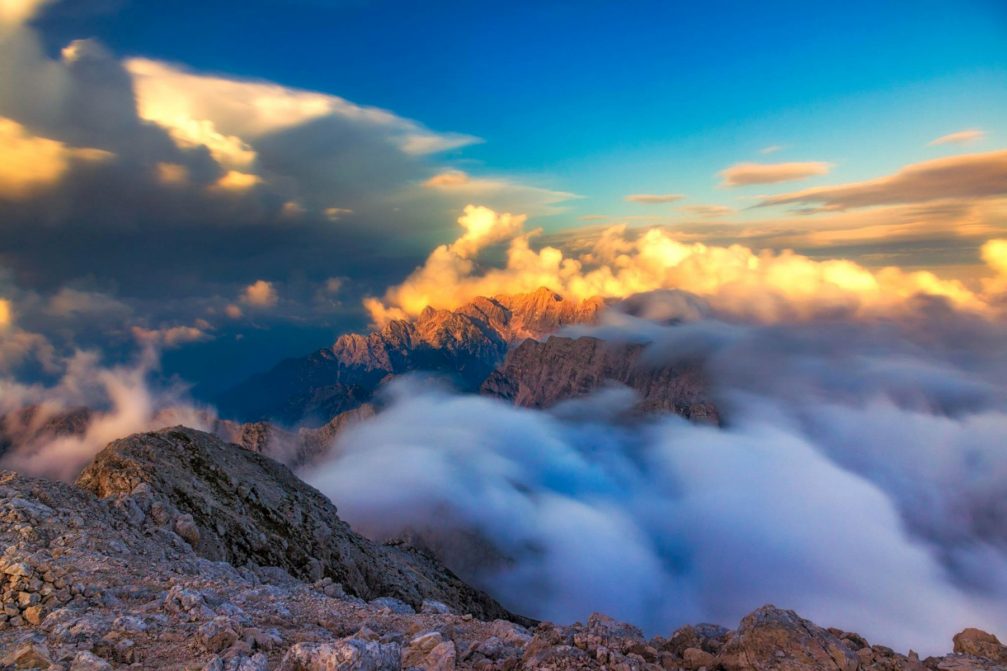
Mangart is a mountain in the Julian Alps, located on the Italian-Slovenian border. With an elevation of 2,679 metres, it is the 3rd highest peak in Slovenia. It is a very popular mountain with several trails that lead to the summit, which offers fantastic views in all directions.
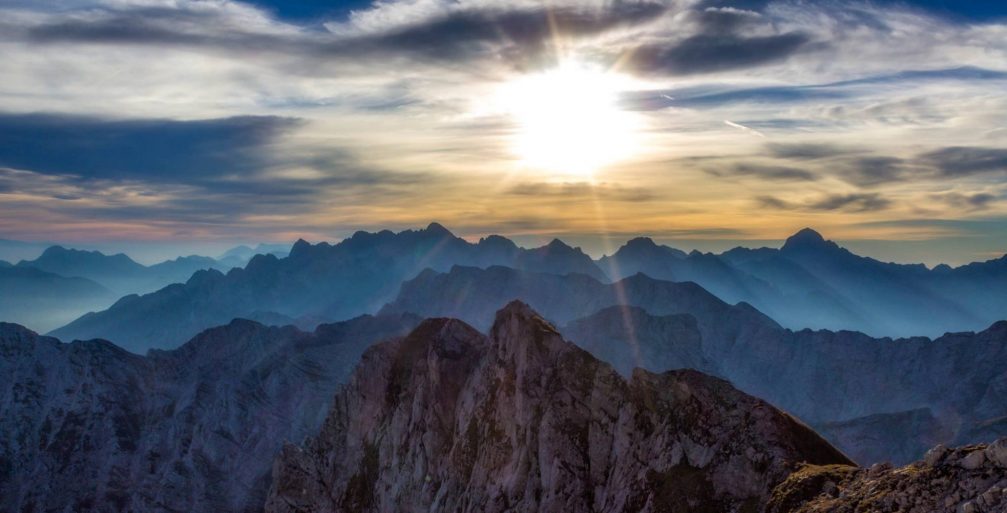
Sunrises in the Alps are quite as glorious to behold as sunsets, but unfortunately very few people rise early enough to see them.
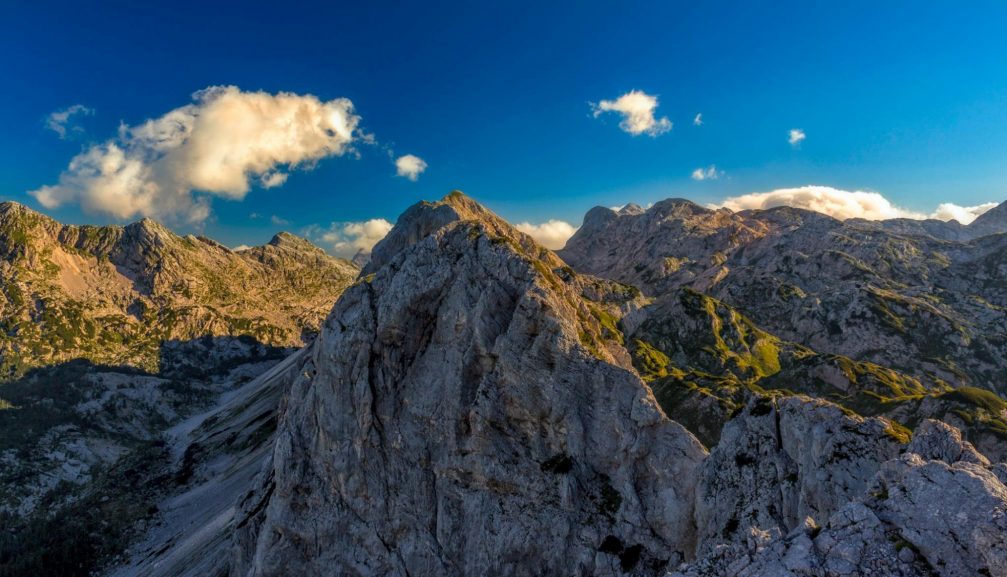
This beautiful view of the 2,091-meter-high Mt. Velika Ticarica can be seen from the summit of the 2,071-meter-high Mt. Mala Ticarica. On the left is the Triglav Lakes Valley and on the right is the Za Kopico Valley.
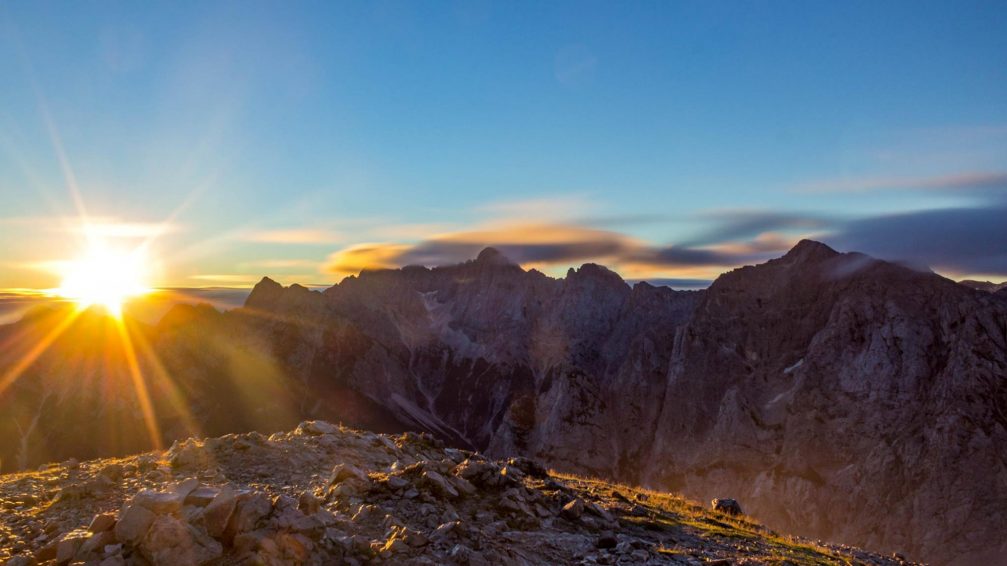
One of the most popular peaks in the alpine area of northwestern Slovenia, with one of the most beautiful views on the highest peaks of the Julian Alps, is the 2,332-meter-high Mala Mojstrovka. It’s very easily accessible from the south side (from the Vrsic mountain pass), while the north one presents more of a challenge.
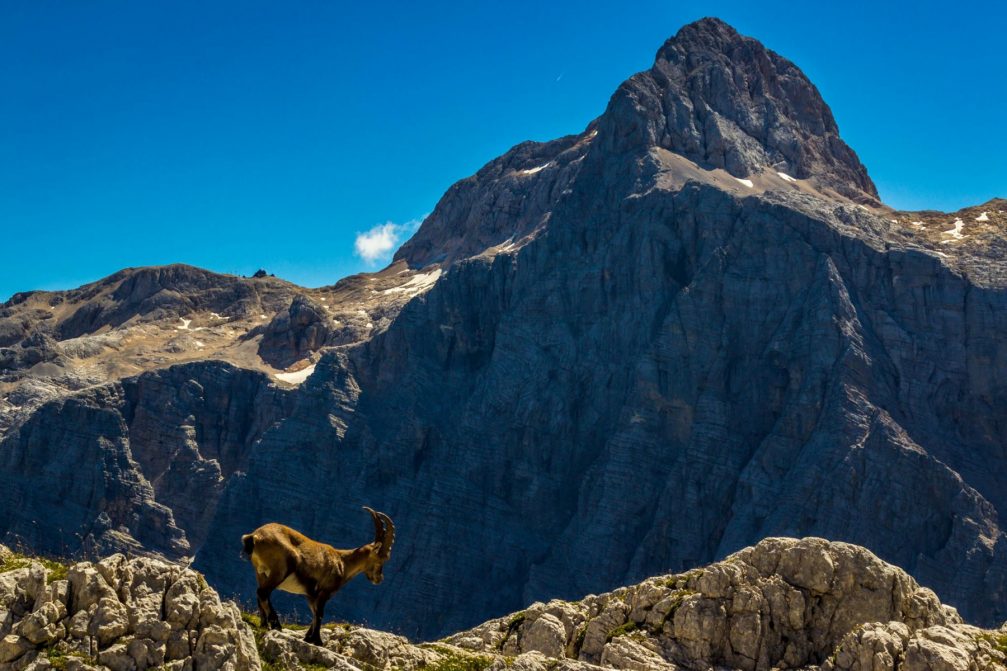
The alpine ibex is a mountain goat that lives high up in the mountains of the European Alps. It’s instantly recognizable by the male’s large scimitar-shaped horns which are ridged in the front. Ibex were hunted to extinction in the early 19th century. By 1856 only 60 Alpine Ibex remained in the Gran Paradiso National Park in Italy. Some of these ibex were smuggled into Switzerland and Slovenia around 1890 in an effort to reinstate ibex in the European Alps. Ibex is now no longer an endangered species. They are frequently sighted in the most rocky and wild regions of the Julian Alps, especially in the Triglav National Park.
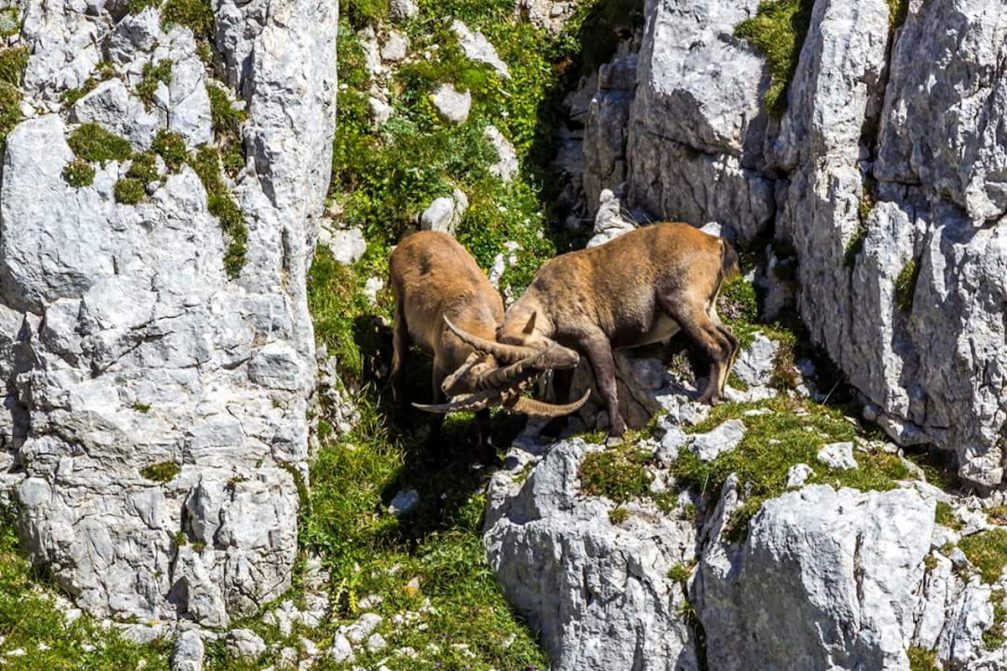
During the breeding season, Alpine Ibex males fight for access to females and use their long horns in agonistic behaviours.
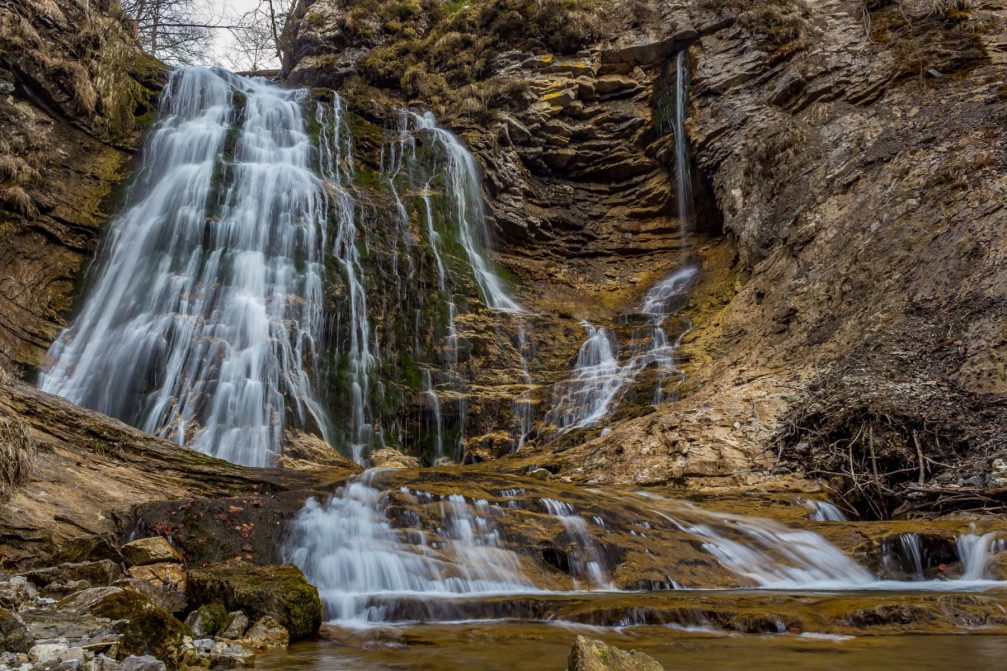
Stegovnik Waterfall or Stegovniski Slap as it is called in Slovene is one of the many beautiful natural sights to discover in the Trzic area. The waterfall falls down an interesting wide wall and is 15 meters high and up to 20 meters wide. It is most magnificent after heavy rainfalls. In order to get to the falls, follow the Stegovnik creek just several hundred metres from Medvodje in the vicinity of Jelendol.
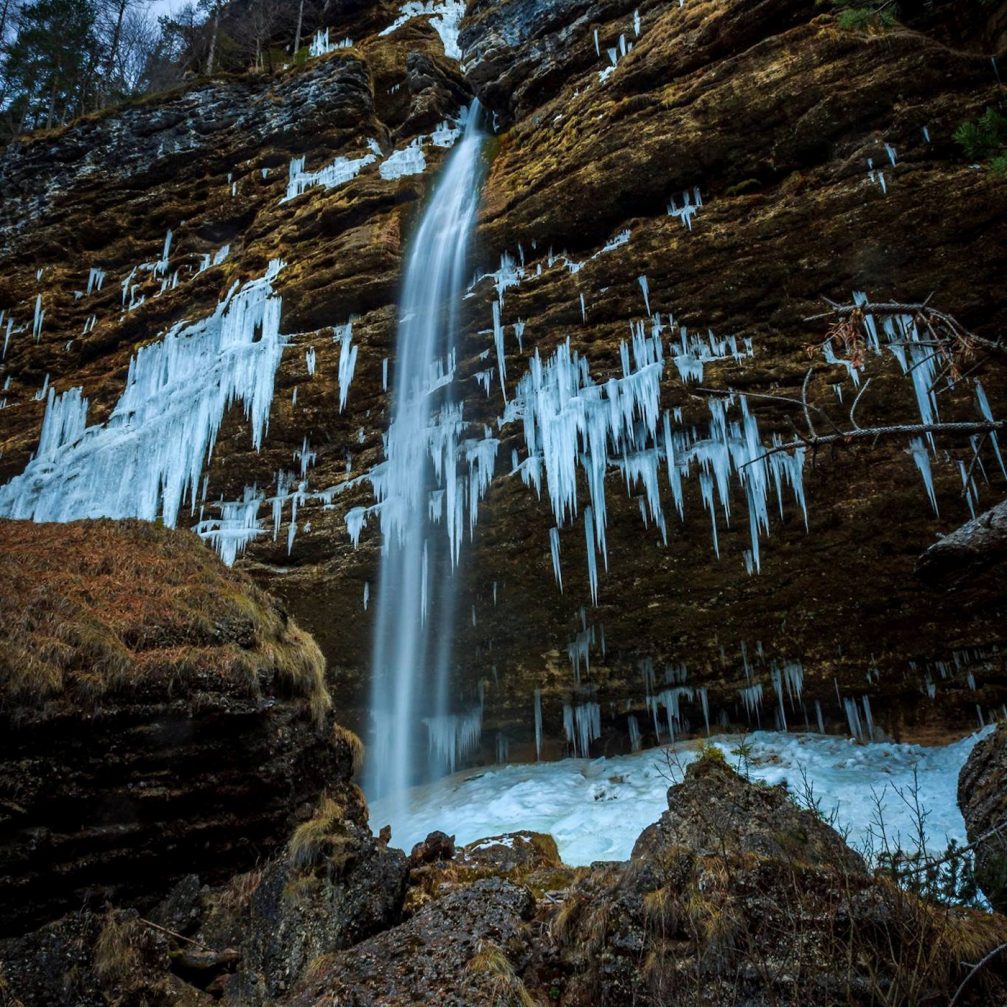
The 52-metre-high Pericnik waterfall in the Vrata valley is considered one of the most photogenic waterfalls in Slovenia. The best time to see the waterfall is in winter when the water freezes into thick curtains of ice.
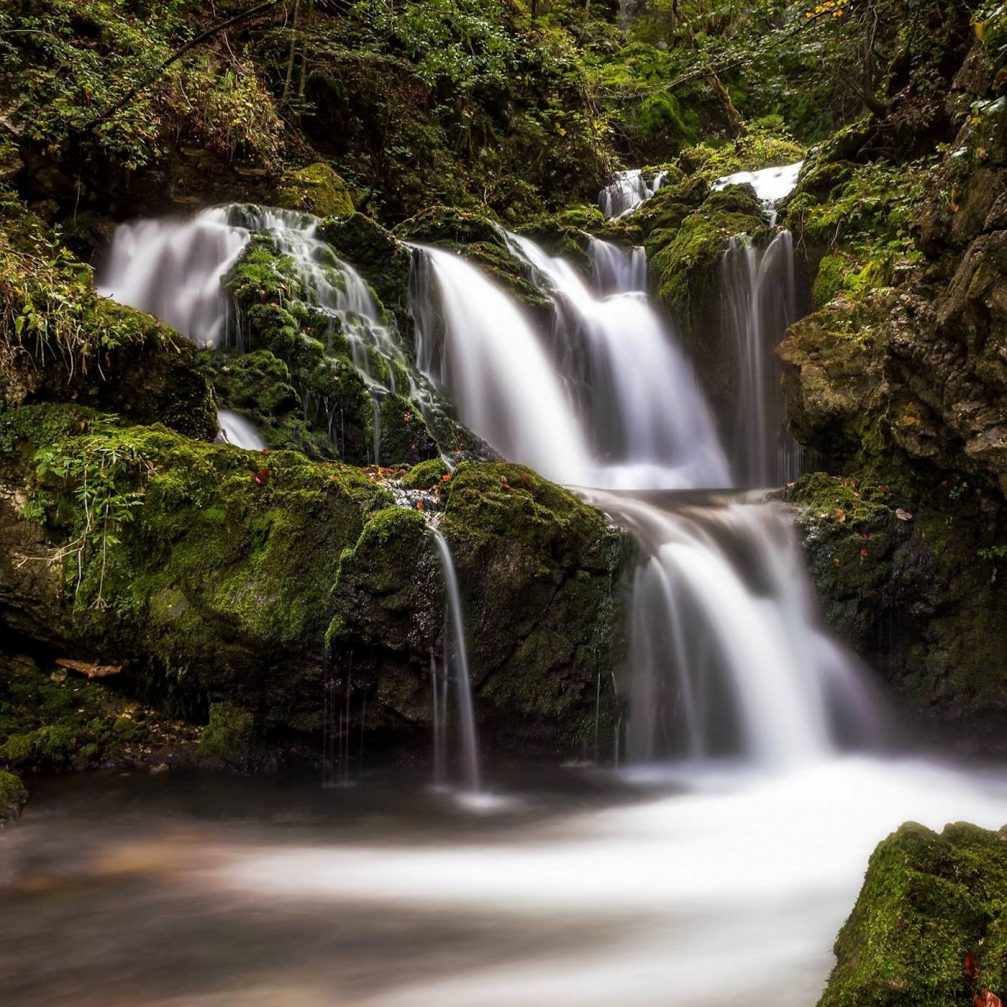
The beautiful cascading waterfall of the Kropa mountain stream in the Voje Valley.
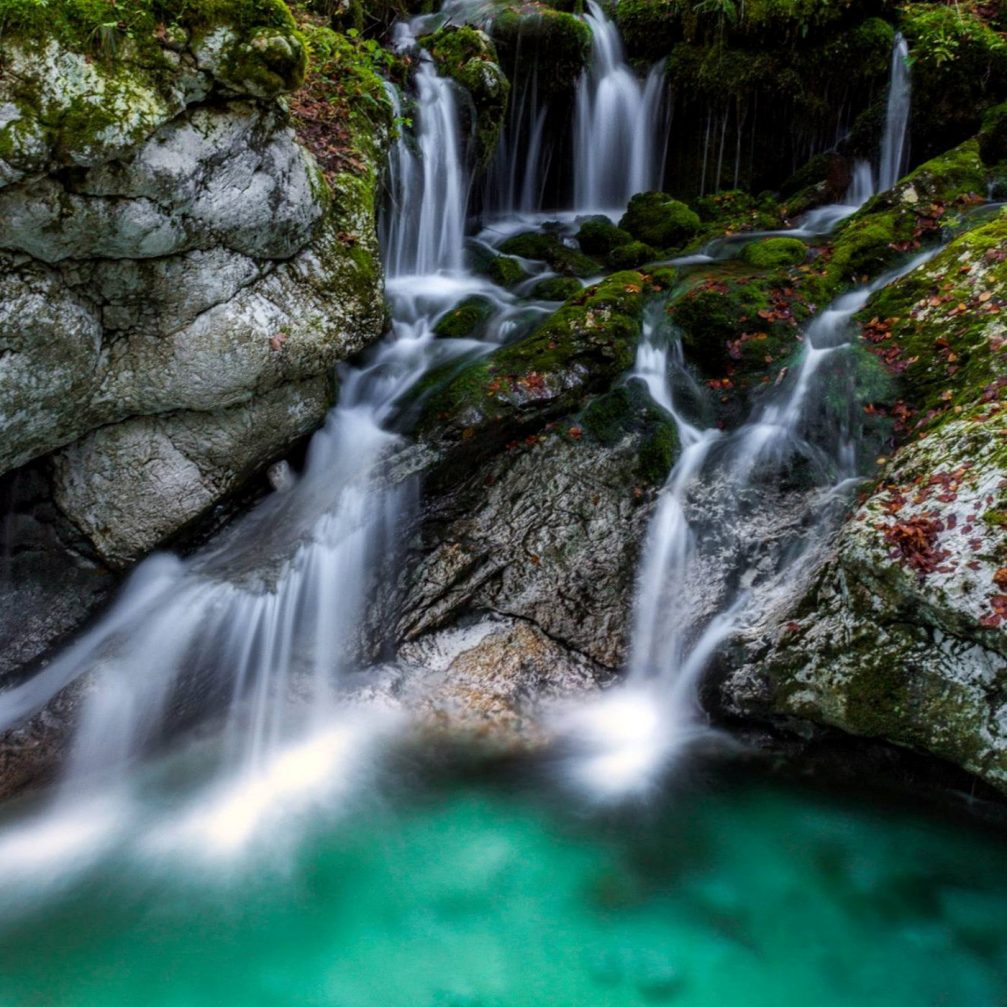
The Water Hurst of Sunik is one of the lesser known hidden gems of the Triglav National Park, located in the Lepena Valley in the vicinity of Bovec. A beautiful place for all nature lovers. It’s impossible not to be charmed by small waterfalls and emerald green pools of the Lepenjica stream.
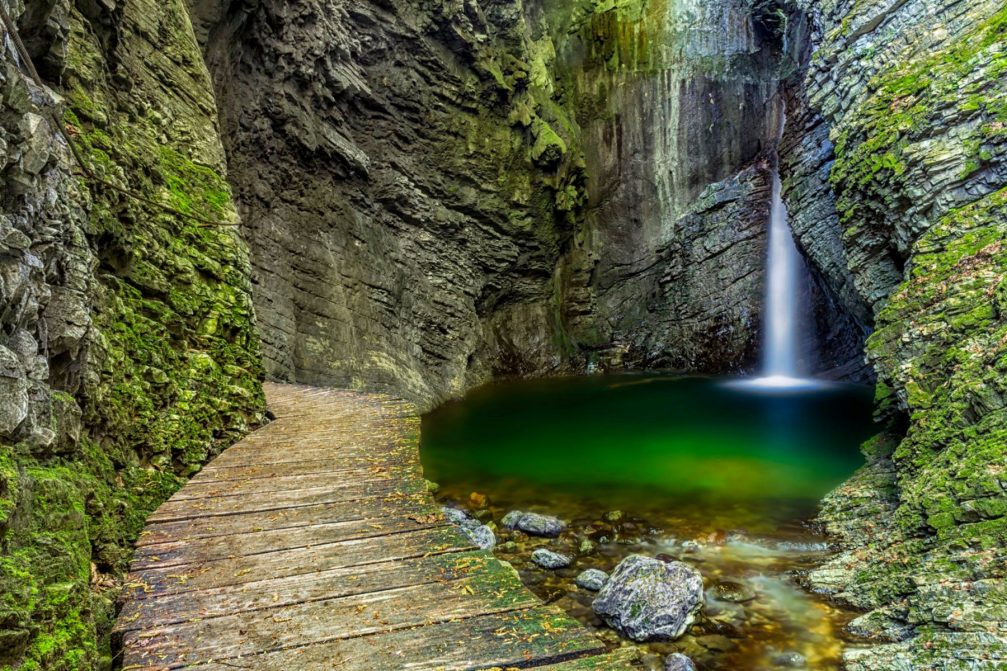
The sublimely beautiful Kozjak waterfall in the Kobarid area. The nice gentle 20-minute walk from parking to the waterfall with great views of the beautiful Soca river along the way is definitely a must do if you are in the area. Once at the site, a short walkway actually brings one into a cave like area where one can view the waterfall.
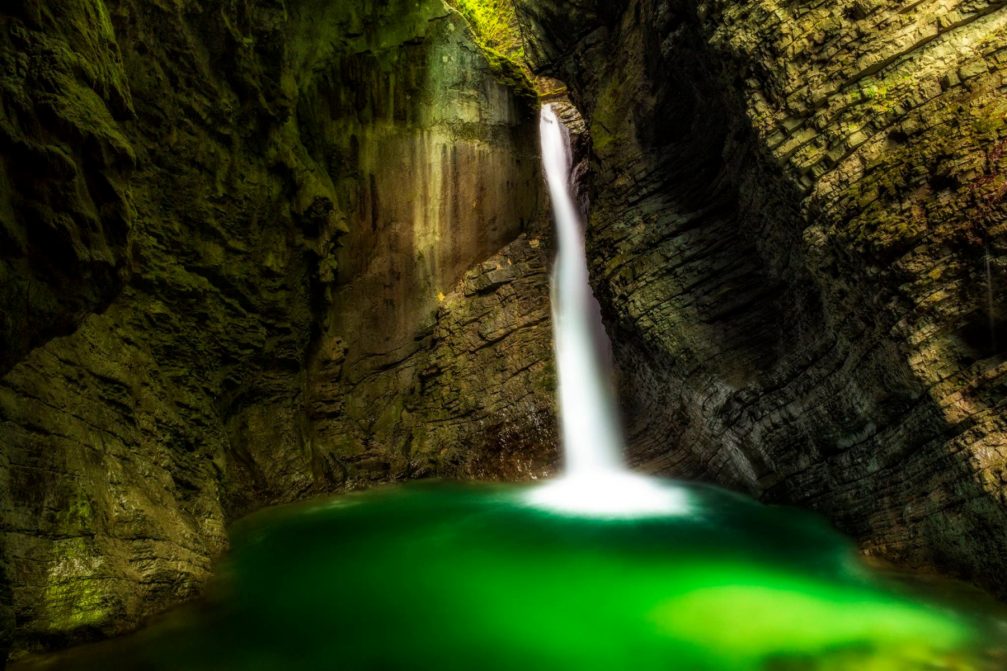
The Kozjak waterfall has eroded a fairly substantial cave for itself in the limestone, with a large emerald-green pool below it. It is possible to swim in the pool, but the water is ice-cold so if you decide to go for a swim, you’d better be mentally prepared for the cold!
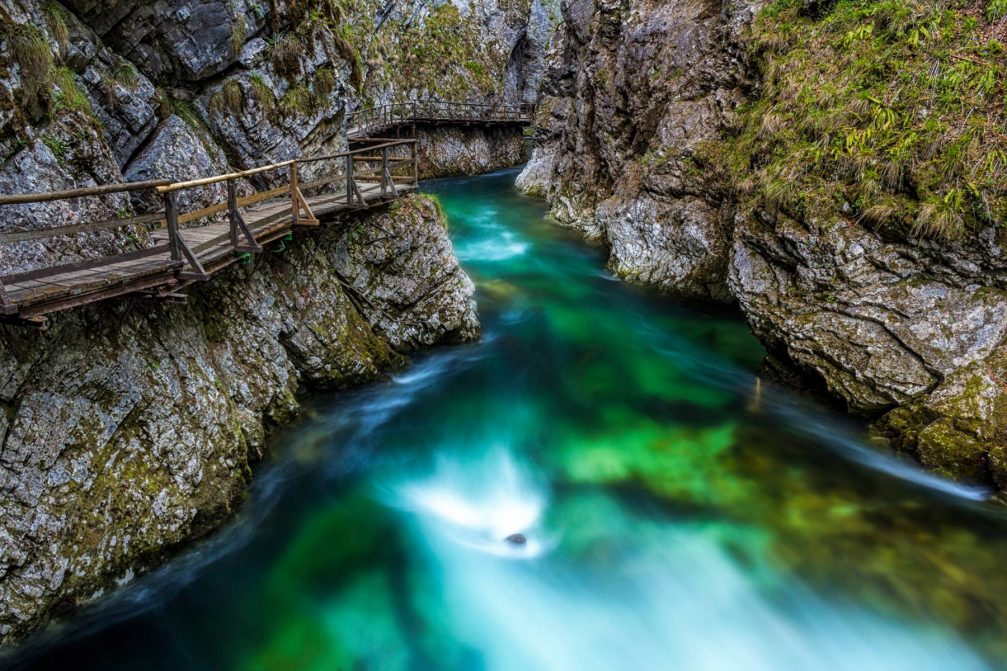
The 1.6-kilometre-long Vintgar gorge is a major tourist attraction in Slovenia, recommended in all guidebooks. The scenery is stunning with a lovely wooden walkway that takes you through the gorge across the thundering rapids and close to some gorgeous waterfalls. The gorge is located just 4 kilometres from Bled along quiet country roads and the signs along the road are clearly marked.
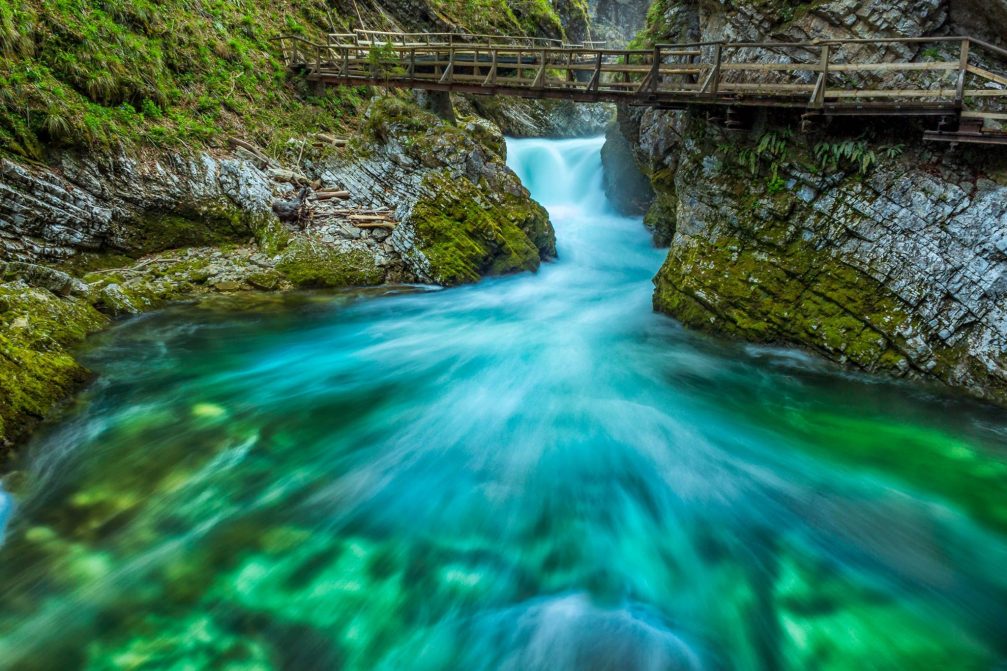
With beautiful cascades and waterfalls, deep canyon with rock walls, beautiful emerald green pools and clear rushing water, Vintgar Gorge is a site you really won’t want to miss if you love the outdoors and are visiting Lake Bled area. Its incredible beauty will leave you amazed! The gorge is part of the Triglav National Park. It’s easy to walk (about 3 kilometres out and back), but plan on taking your time to get through it. Camera is a must, and good walking shoes too!
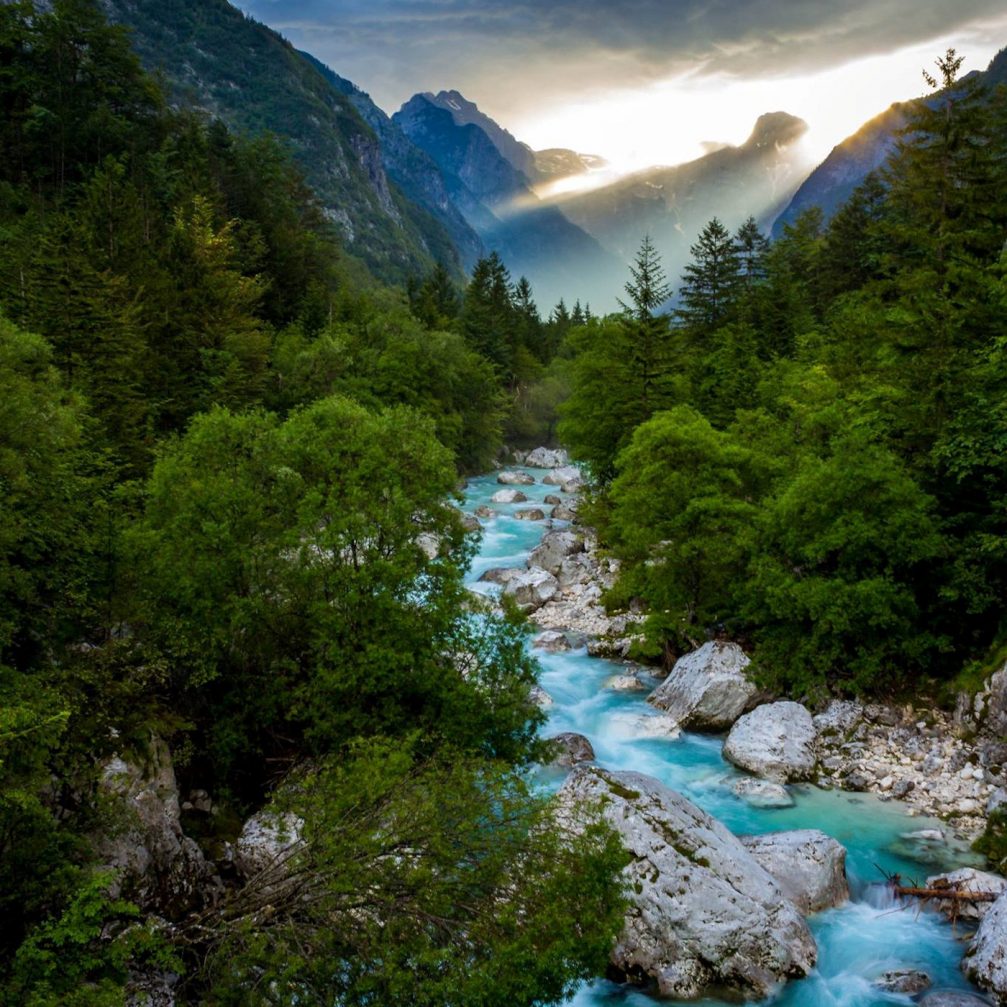
The fact that Slovenia is a land of water is most eloquently asserted by its spread network of rivers. Over many millions of years, rivers have determined the image of the landscape and created numerous valleys. Nature lovers from around the world are of the unanimous opinion that the Soca is one of the five most beautiful Alpine rivers which have retained their picturesque originality. The beauty of the river is enhanced by its milky blue-green colour, very deep river troughs and valleys, waterfalls, boulders, river terraces and exquisite views of the surrounding mountains. The poet Simon Gregorcic once wrote of the Soca river that it was a ‘lucid daughter of the mountains, graceful in all her natural beauty‘, something which still stands to this day.
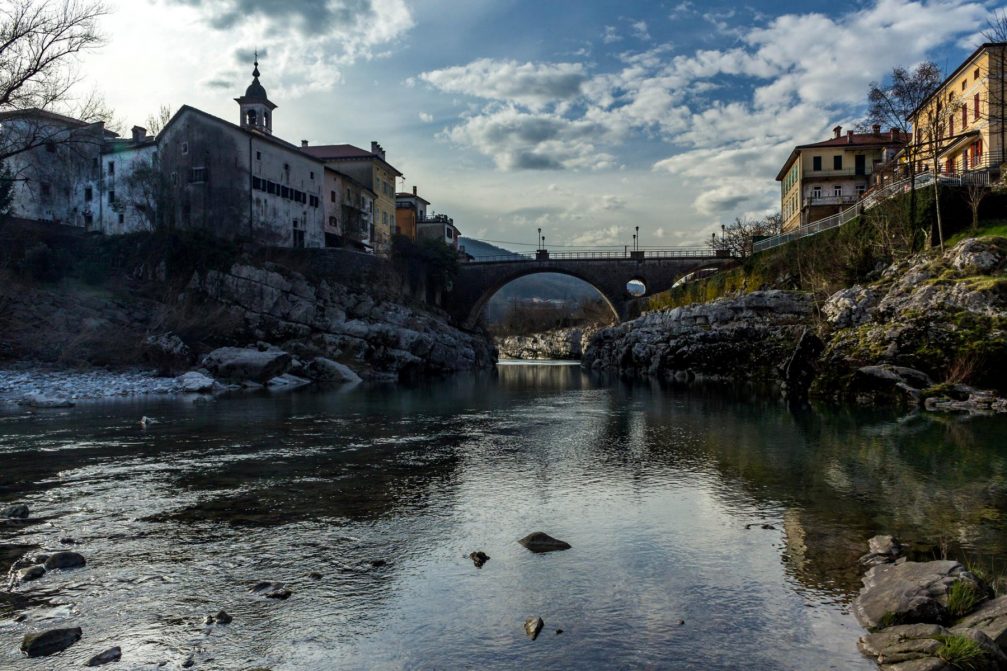
Kanal Ob Soci is a charming small town that straddles both banks of the Soca River, and is connected by a 17-metre-high twin-arch bridge best known for hosting a very popular diving event every August, featuring divers from Slovenia and abroad jumping into the emerald water of the Soca river below.
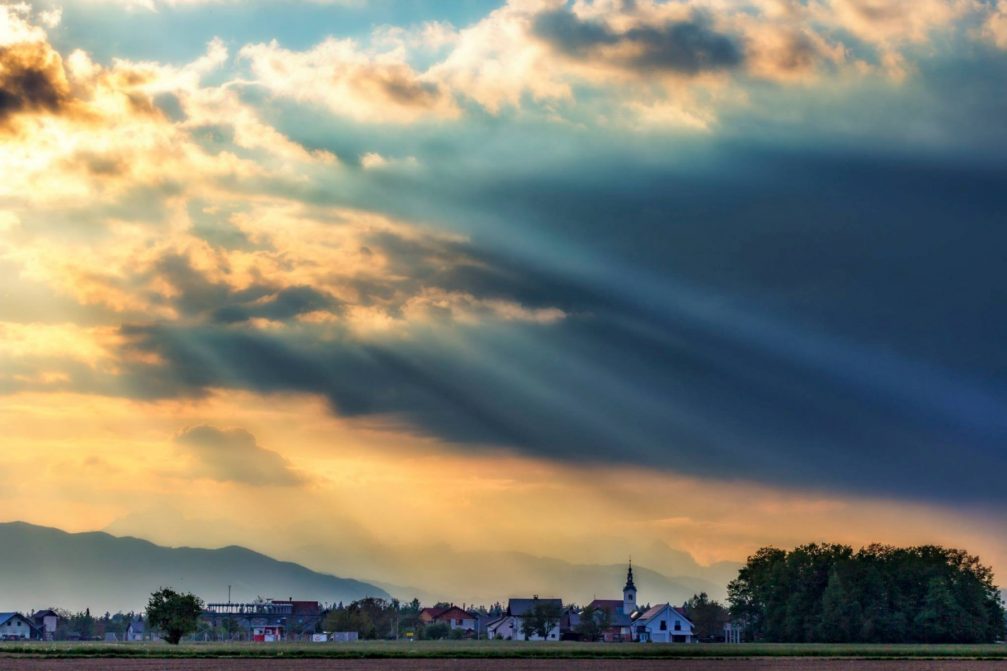
Sencur is a lovely small town in the vicinity of Kranj, the capital of Gorenjska region, which is part of the Slovenian Alpine area. Sencur’s best known landmark is the Church of St. George which is a single-nave structure with a rectangular chancel with beveled corners that was built in 1747 on the site of an earlier building.
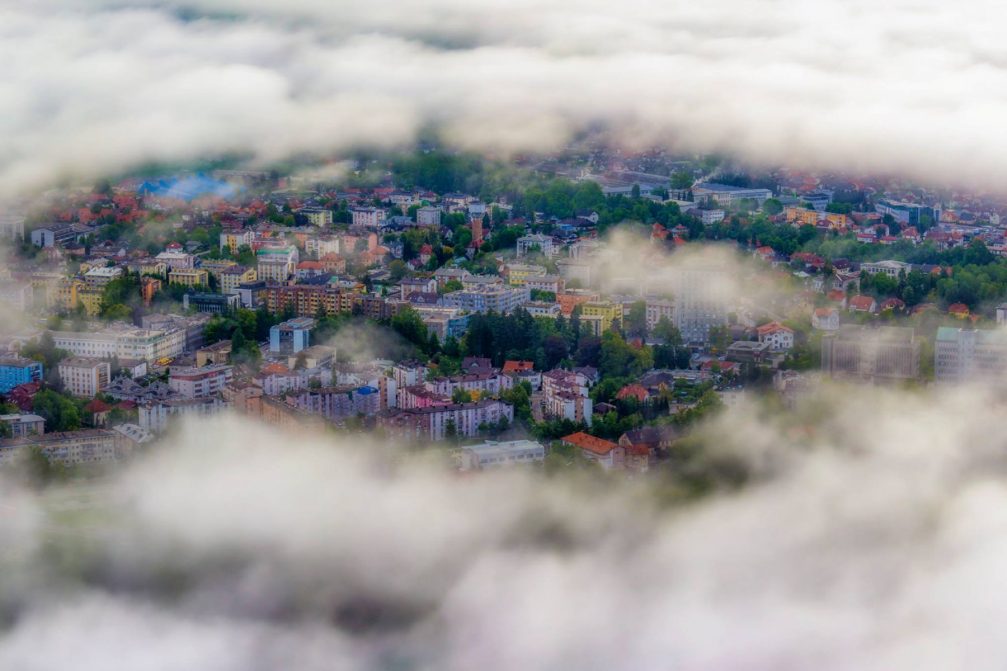
with a population of about 37,500 inhabitants, Kranj is the fourth largest city in Slovenia and a very important economic, transport, educational, cultural and sports centre of the Gorenjska region.
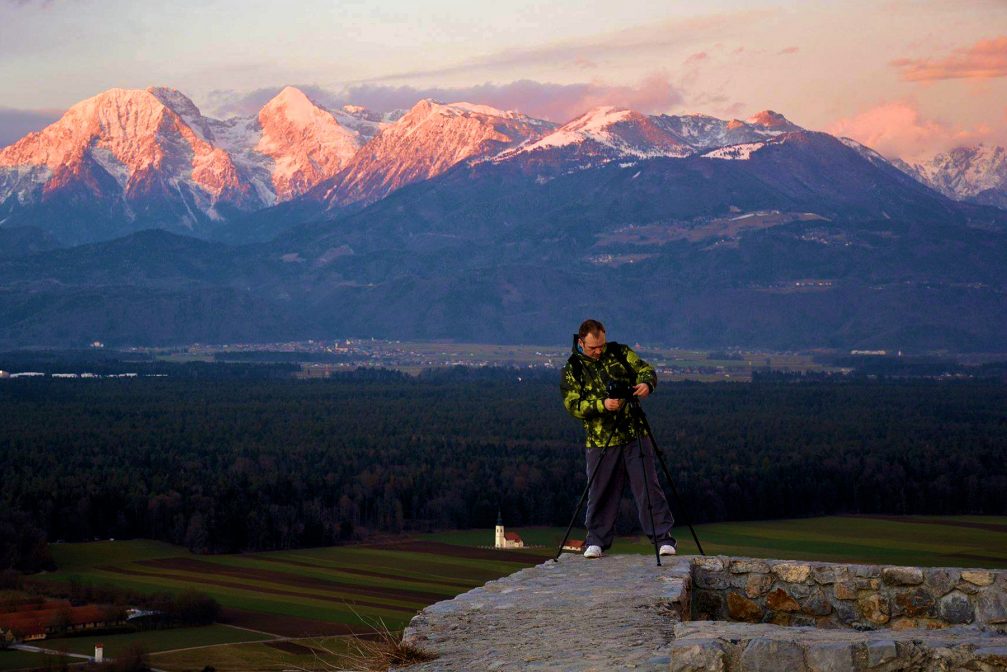
Thank you so much for sharing your fantastic photography with us Miroslav. Your photos are fabulous and perfectly convey the beauty of nature and landscapes in Slovenia.
| |
|---|
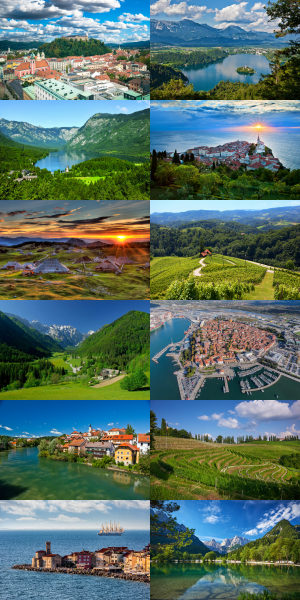 Discover beautiful Slovenia through amazing photos that will instantly make you want to visit and explore this delightful country in the heart of Europe. View more than 100 galleries with more than 5.500 landscape and nature photos from 50+ photographers! ENJOY! |
| |
|---|
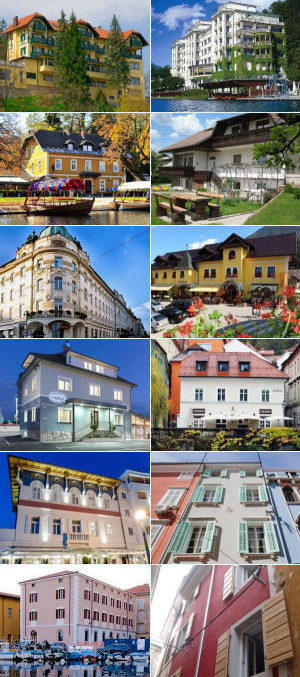 There is a wide array of options for accommodations in Slovenia, including hotels, guest houses, apartments, bed and breakfasts, hostels, camping and glamping sites and farm stays. Find out which places to stay in Slovenia we recommend and why! |


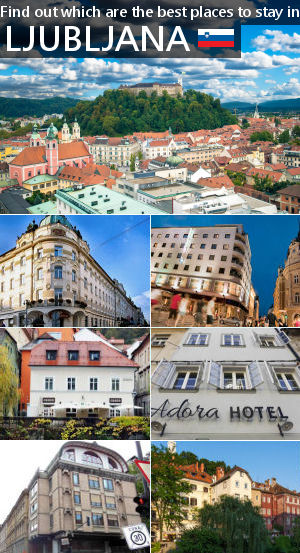
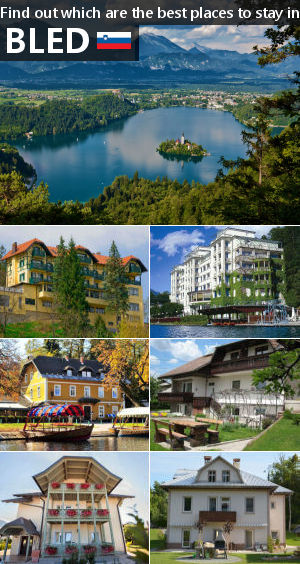
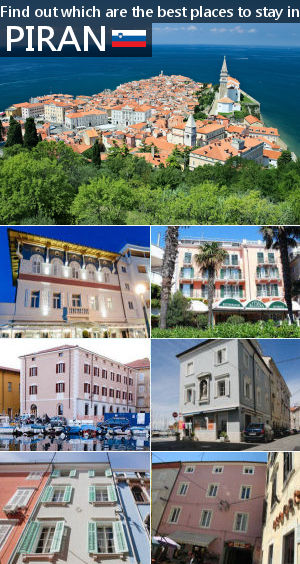

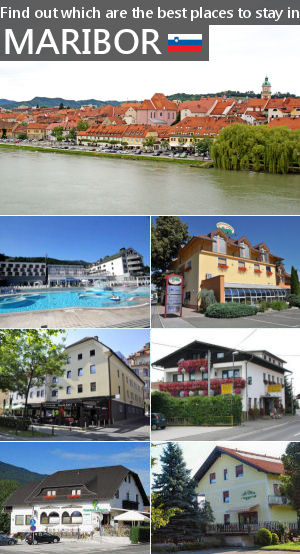
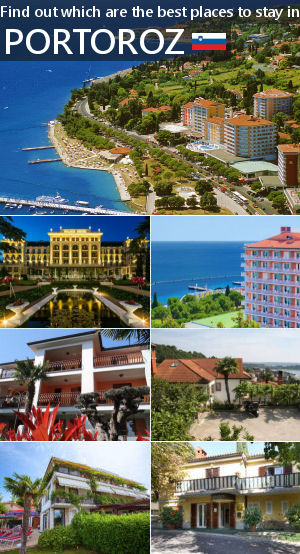
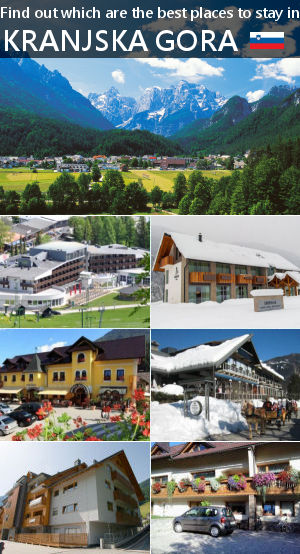
These pictures are absolutely wonderful!
So magical! Slovenia is such a special place!
Your photos continue to captivate me. Slovenia is one of my dream vacations and after all of these galleries, i just want to jump on a plane right now!
I loved seeing all of the pictures. Slovenia really is a dreamy country. Thanks for sharing.
Through these pictures, I would like to go on a trip to Slovenia!
Oh, I definitely need to include Slovenia to my 2017 itinerary! Looks so wonderful.
Wonderful pictures! i love Slovenia so so much.
These pictures were awesome. Thanks for taking us through Slovenia with you.
Absolutely beautiful and heart warming photos. ifeelsLOVEnia!
Beautiful snaps! Slovenia is the type of places I could quite happily live on for the rest of my life.